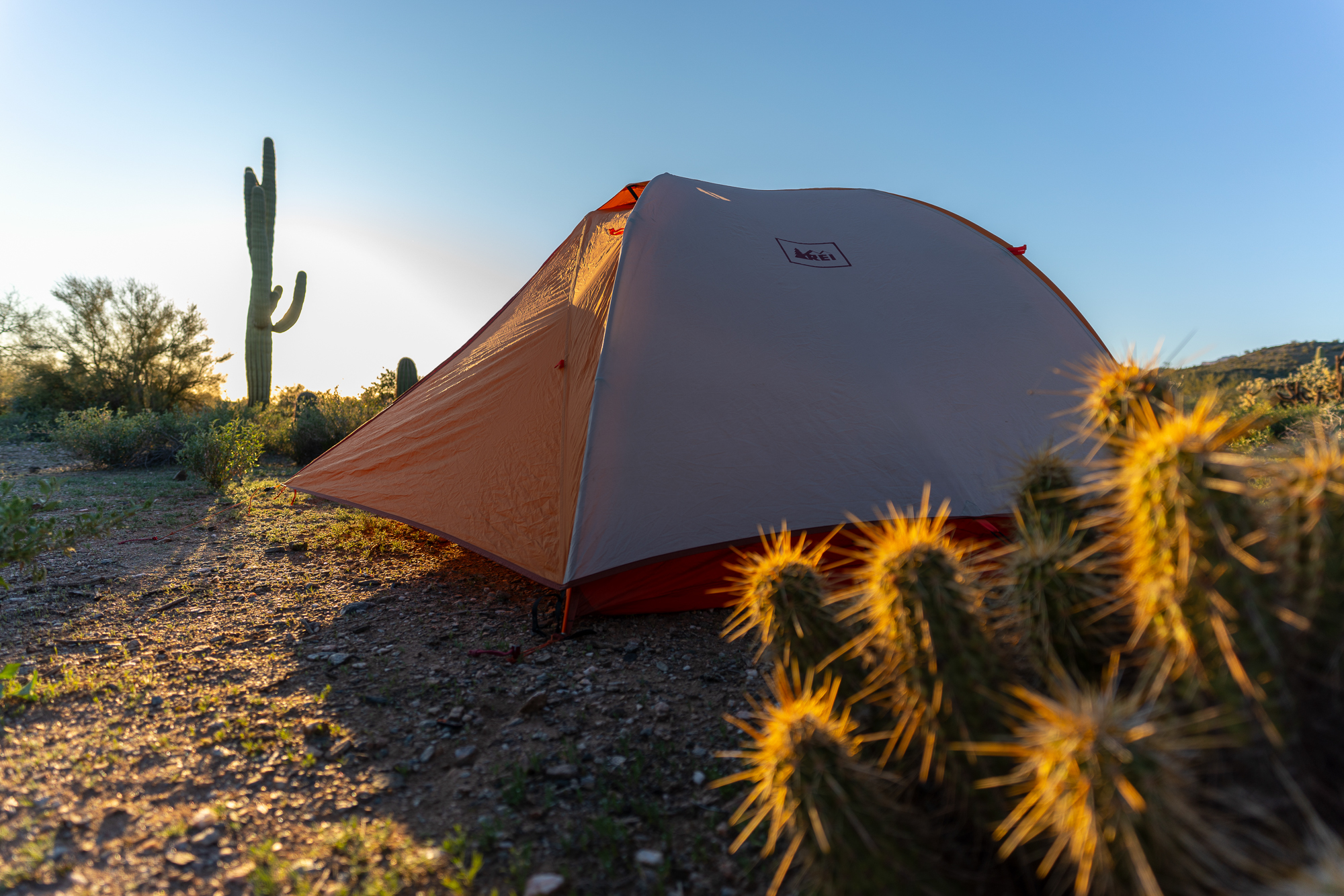Editor’s Note: This article on tents was originally published in Overland Journal’s Summer 2022 Issue.
I toiled in the desert sun, slept under the stars, got bloodied, spilled beers, and picked cactus spines out of my fingers and feet for days to develop some opinions on this selection of ground tents.
What’s that, you say? I thought overlanders only slept in rooftop tents. Well, contrary to popular belief, sleeping on top of your rig is not necessary for overland travel. And as it turns out, sleeping on the ground is advantageous, even enjoyable at times, without the added hazard of falling off a ladder when nature calls at midnight.
When it comes to shelter, ground tents are less expensive, significantly lighter, and infinitely more compact than rooftop tents or trailers, for that matter. They can also be pitched in many places where travel trailers can’t be towed or where vehicles cannot drive. A ground tent can also be a versatile second shelter, allowing you to “keep” a campsite when you want to remain in one spot but have the ability to escape for short day trips.
But not all ground tents are created equal, and with so many designs to choose from, where should you begin?
What Hundreds of Nights and Thousands of Trail Miles Have Taught Me
I have logged hundreds of nights under silnylon and canvas shelters in national forests and wilderness areas across North America and beyond. This includes everything from permanent platform tents with canvas covers in the Adirondacks to single-wall tipi tents on extended winter ski tours, and even under a 14-ounce flat tarp with no bug netting while I was hiking the entirety of the John Muir Trail. This latter decision was not my smartest given the density of blood-thirsty mosquitoes in the Eastern Sierra; however, it was a good learning experience. In short, I’ve set up, weathered storms, and slept in an extensive variety of shelters.
Through all of these experiences, I’ve learned a few valuable lessons. For instance, if you are planning to do a lot of camping on solid surfaces like rock, or even wooden platforms, you will most likely need a free-standing tent unless you are willing to go through a much more complicated process to pitch your tent.
Here’s another valuable takeaway: inexpensive tents can vary drastically in quality. The deluxe $80 eight-person tent from Walmart that I called home in the Volcanic Tablelands outside Bishop, California, was fine in fair weather but got flattened by moderate winds and ended up in the trash after a month of use. However, my single-wall tarp tent from Black Diamond that cost less than $200 lasted for the better part of a decade before it required its first repairs. It held up to high winds, hundreds of miles of hiking through the Northeast, and multiple jaunts along sections of the Pacific Crest Trail. After all that, a zipper replacement and some light sewing work were the only care it needed to stay in rotation.
A tent’s ability to withstand high winds often comes back to the layout of its poles and guylines. The more times a tent’s poles crisscross one another, the stronger the end result. But this is not a hard-and-fast rule. For instance, tunnel tents, some of the most stable in high wind, don’t often have any crossing poles in their designs.
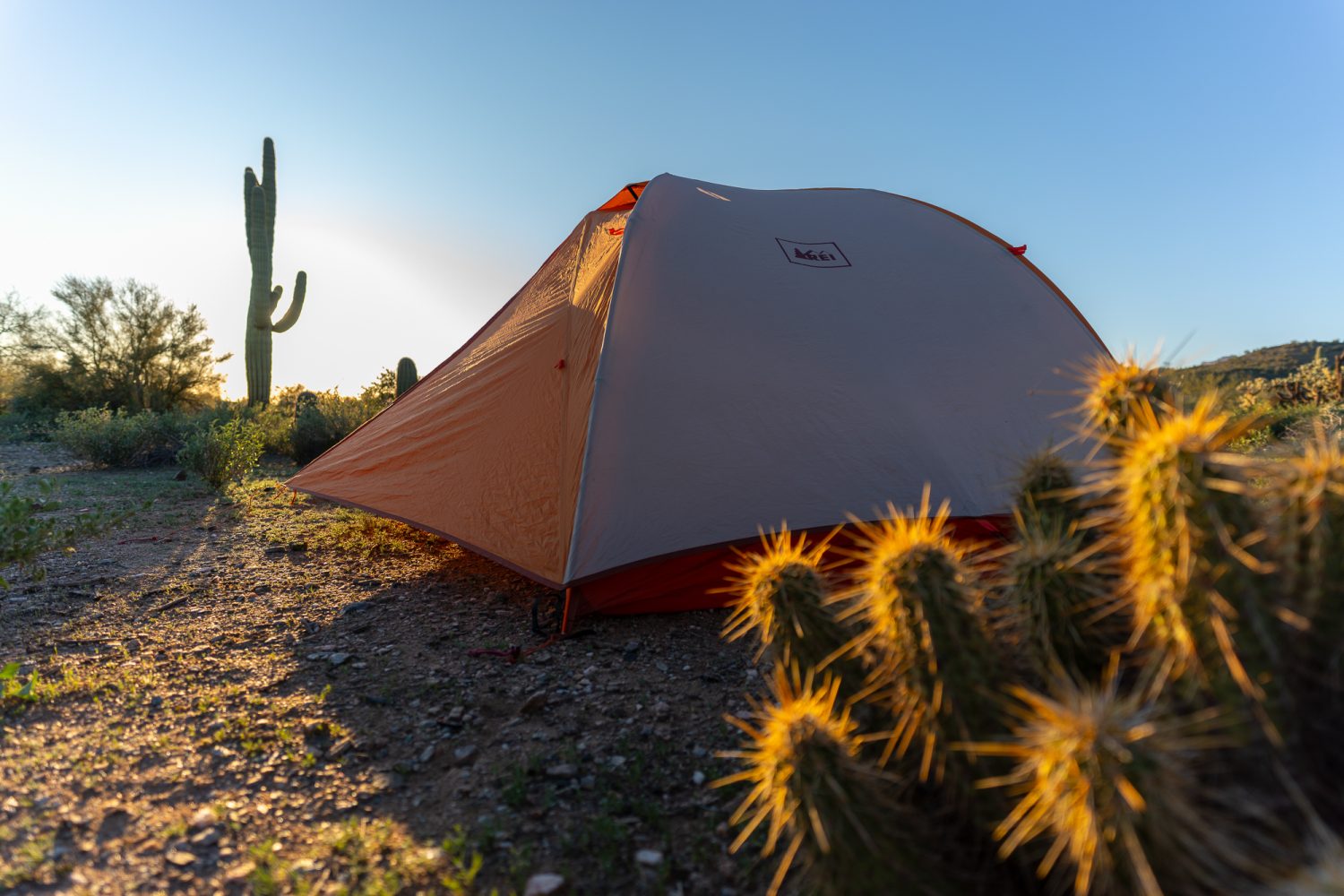
Types of Tents Included
- Yurt-style all-purpose tent: Big Agnes Mint Saloon
- Square floor plan all-purpose tent: Nemo Wagontop
- Compact, lightweight tent: REI Co-op Half Dome 2
- Tipi-style tent with woodstove: Seek Outside Redcliff
- Heavy-duty canvas tent: Springbar Traveler
- High-strength tunnel tent: Hilleberg Keron 3
Let your adventures guide your decision-making process. Do you frequent areas that have mosquitos? Then you’ll benefit from bug protection. Maybe you like to continue camping through the winter months, in which case you’ll want a tent with enough structure to handle strong winds and the extra weight of snow. Group size and the terrain you plan to utilize a tent in should be primary considerations. You will also have to decide if you want standing room and a more cutting edge or traditional design. Jot down some key features you’ll need before browsing online or heading to the store; this way, you’ll be more likely to stay on track instead of being lured into something fancy looking that is unproven in the field.
Rough Camp Gear Tent Stakes
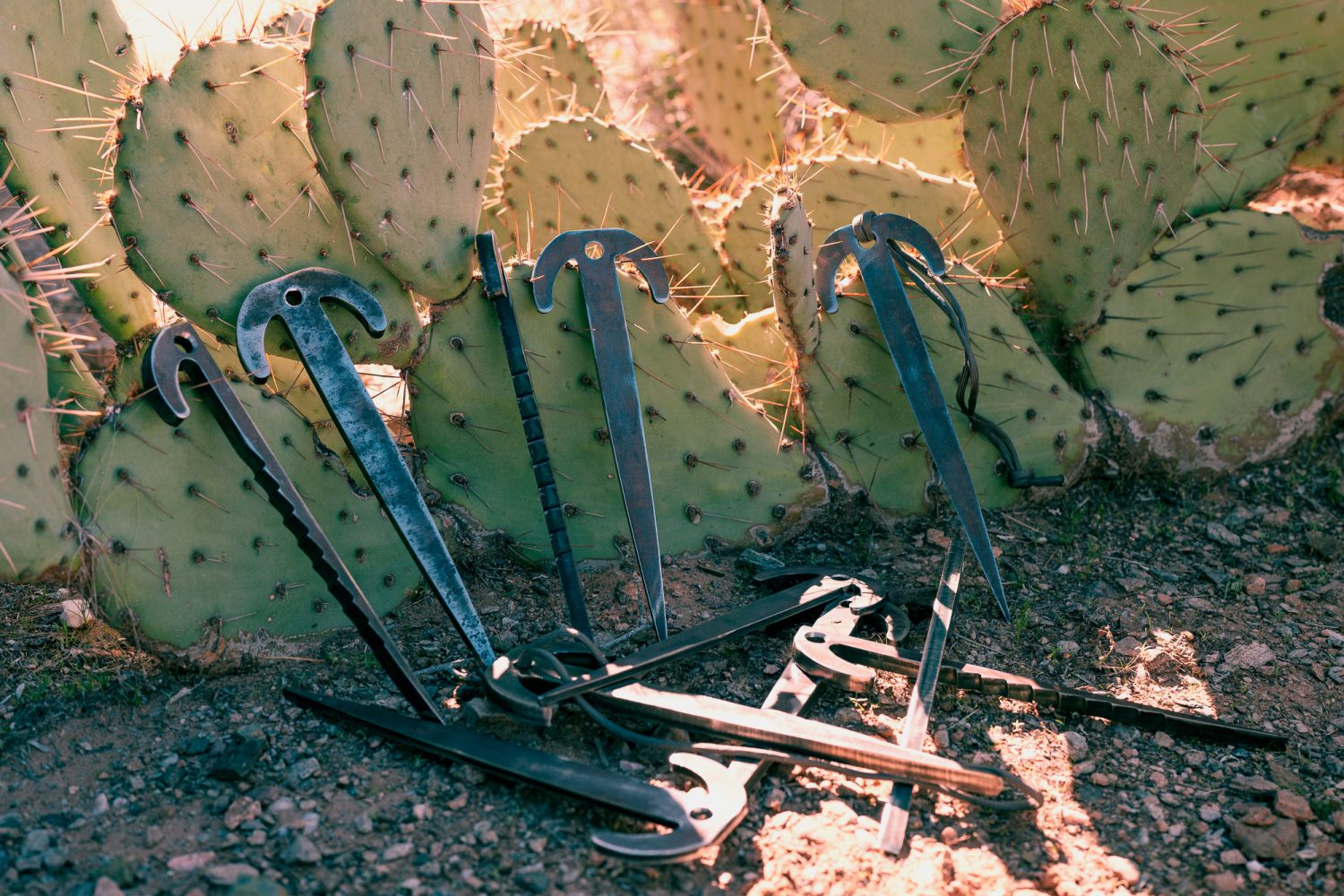

Before we get into the details of the tents, I wanted to cover one additional topic: tent stakes.
I’d wager a bet that you’ve come across lost or discarded tent stakes over the course of your overland journeys. Generally, you find them completely bent to heck or pounded so far into the ground that they have practically disappeared. Both of these scenarios are unacceptable, resulting in wasted money and trash being left behind on our public lands.
For the purposes of this test, I brought along a secret weapon in case any of the supplied tent stakes weren’t up for the task at hand: Rough Camp Gear’s US-made, heirloom-quality steel tent stakes. These titans of holding power come in a variety of shapes, lengths, and thicknesses. They are superior to conventional stakes in almost every way, although because of their weight (ranging from 1 5/8 to 13 ounces each), I like to reserve them for vehicle-based camping (no backpacking with these bad boys). Rough Camp stakes can be pounded into the ground with a compact sledgehammer or the butt of a hatchet with little worry of bending. Also, the unique shape of their heads, which has a hole through the middle, ensures plenty of options for securing your tent and guy lines to the ground.
My go-to has been the 3/16-inch-thick Legacy stake with hole, which weighs 6 ounces, and strikes a perfect balance of durability without being excessively heavy. I should mention that I utilized some of the 3/8-inch-thick stakes for heavier tents, like the Springbar Traveler.
$8 to $14 each | roughcampgear.com
Big Agnes Mint Saloon
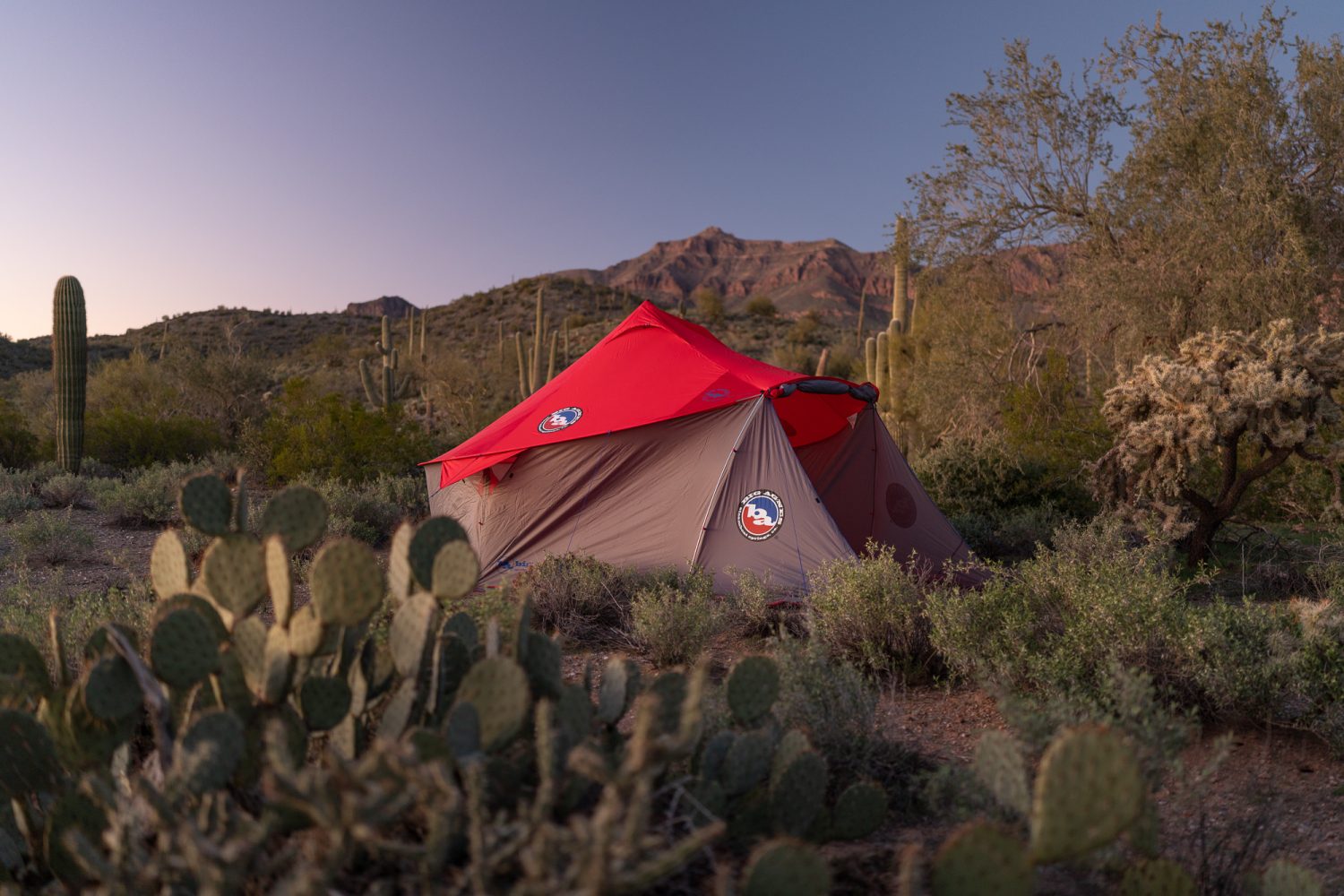
Colorado tentmaker Big Agnes wants to inspire others to get outside and enjoy the backcountry, just like they do. They are based in Steamboat Springs, Colorado, where they design and test their products, ranging from Crazylight (single-person, 1-pound models) to four-season mountaineering shelters that can withstand winter storms.
The Mint Saloon is a roomy, single-wall, yurt-style tent that can fulfill a range of uses, from mess hall to bunkhouse. The total packed weight of the Mint was slightly over 12 pounds, including all poles, stakes, and the carrying bag, which organizes everything into a bundle and has convenient carrying handles. Note that the tent comes with 15 aluminum stakes, yet it requires 17 to fully secure all ground loops and guylines.
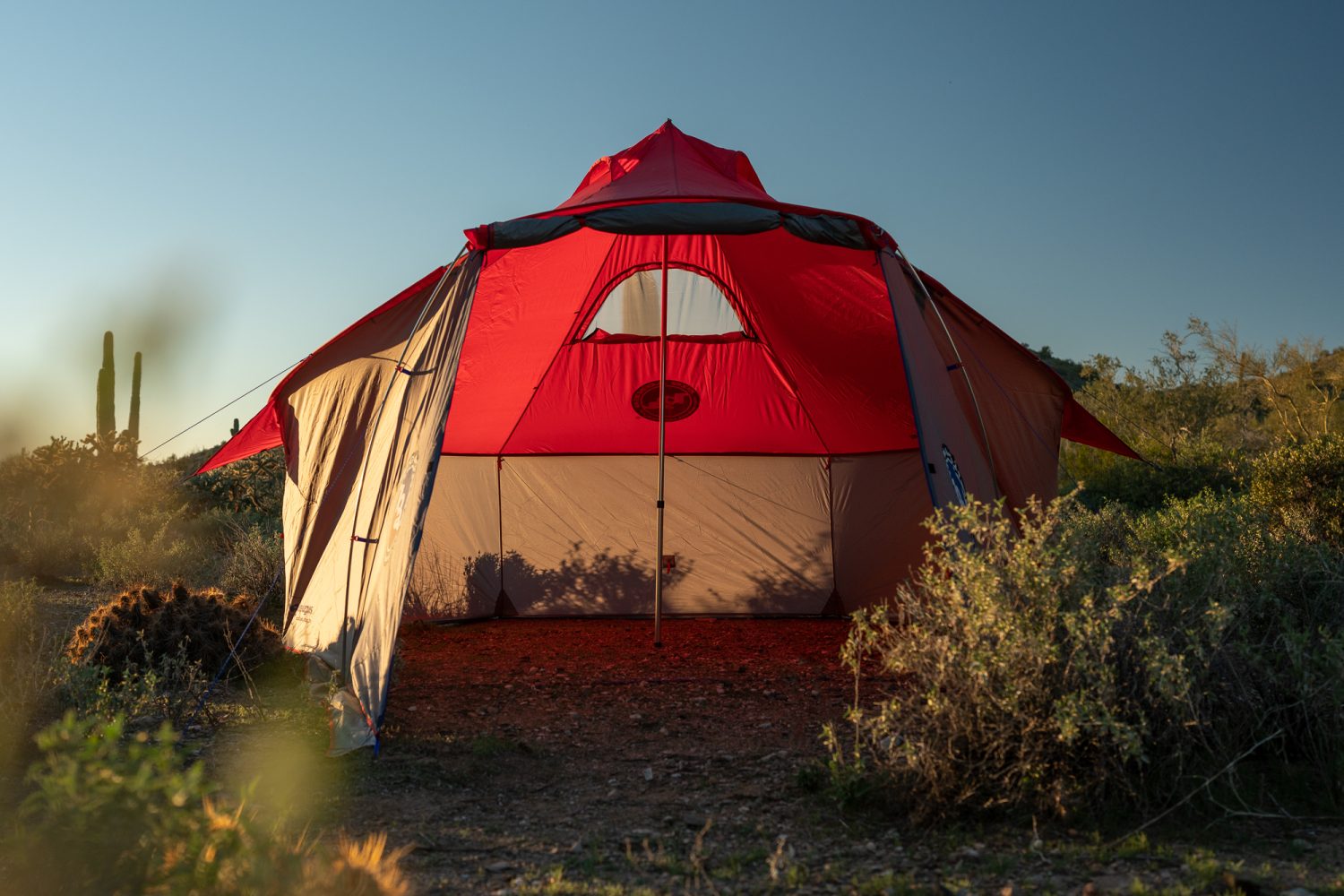
It took me approximately 45 minutes to set up the first time (solo, although I would recommend at least one helper) without using any instructions. Setup is slightly more advanced due to the tent’s unique shape and numerous staking points. Even if you are a seasoned tent user, you will likely need to restake at least a few of the ground anchors to get the Mint pitched just right. Because it is not free-standing, it won’t realize its maximum stability until fully staked out.
When it comes to using the Mint Saloon, or mansion, as I’ve come to refer to it, you will not be left wanting more space. It can sleep up to eight people with 102 square feet of volume. And nearly all of this space is usable, thanks to vertical lower walls. A centrally located aluminum pole supports the ceiling and can extend to a maximum height of 100 inches (that’s over 8 feet tall). This makes for comfortable standing room throughout most of the tent, with enough headroom to sit in camp chairs around the inside of its perimeter.
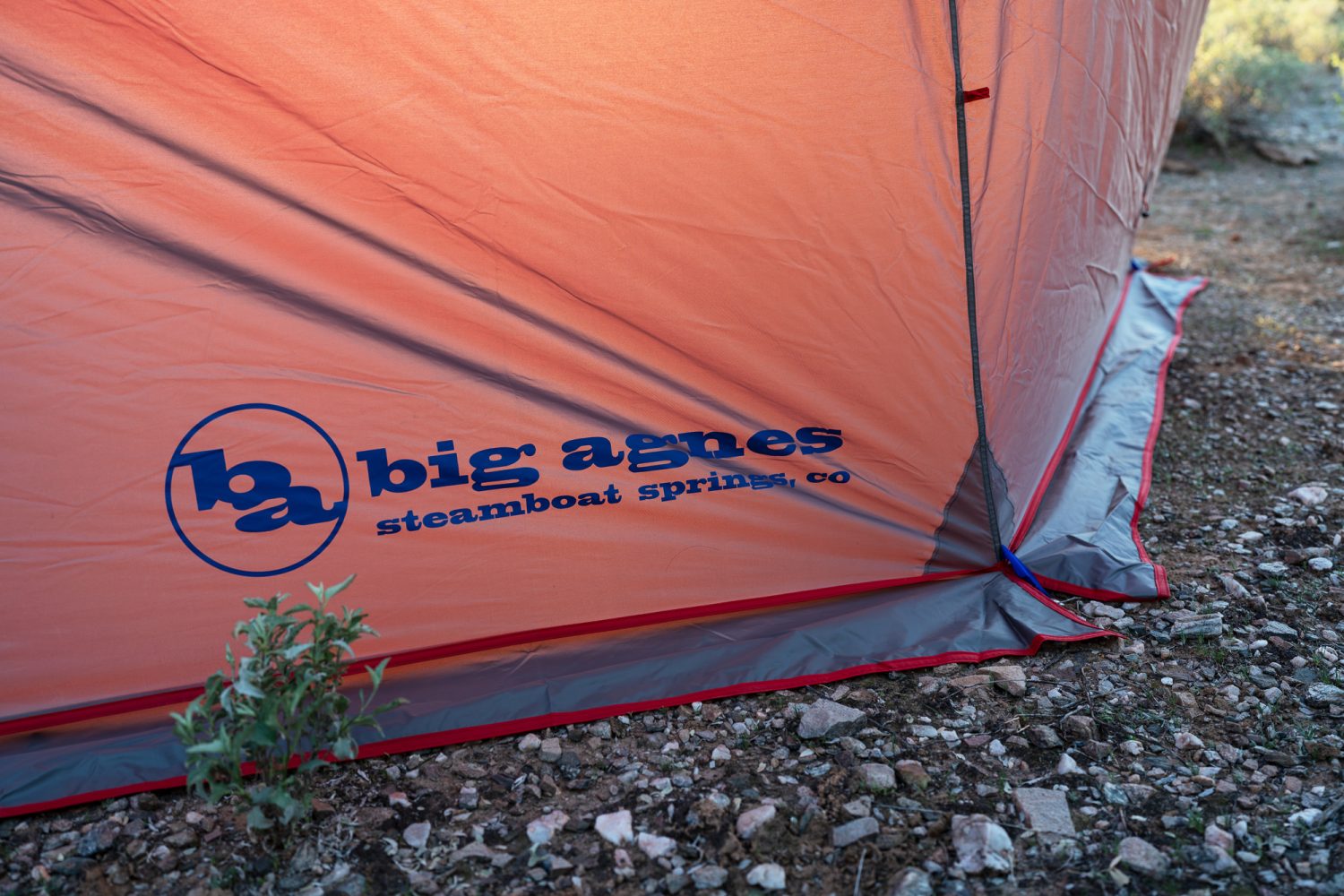
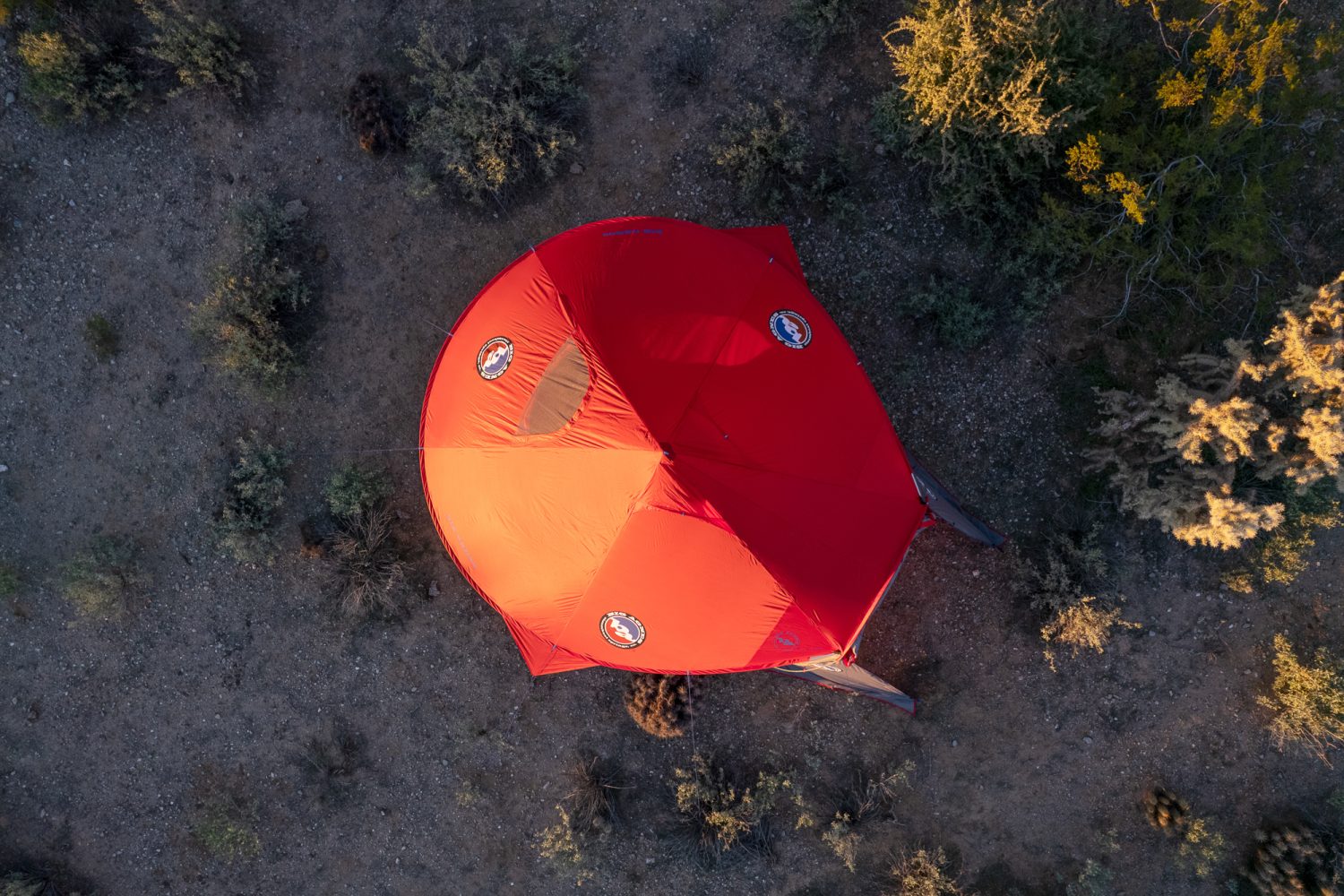
.
The single-wall, floorless design means that you don’t have to worry about taking your shoes off when entering the tent; there’s no floor to damage or get dirty. But this also means less protection from critters getting inside the tent if they want to. To provide a little bit of additional protection from the elements and animals, the Mint features a skirt around its perimeter which can be weighed down with rocks or other found materials, creating a more sealed-in feeling.
The Mint felt a little flimsy in moderate winds in the Arizona desert, and because of this, I would reserve it for three-season use in fair weather conditions only. Despite this fact, if you are looking for a cavernous hangout space for a large group of friends, an indoor kitchen, or a cabana for bedding down the entire caravan, the Mint can accommodate.
$500 | bigagnes.com
NEMO WagonTop 4
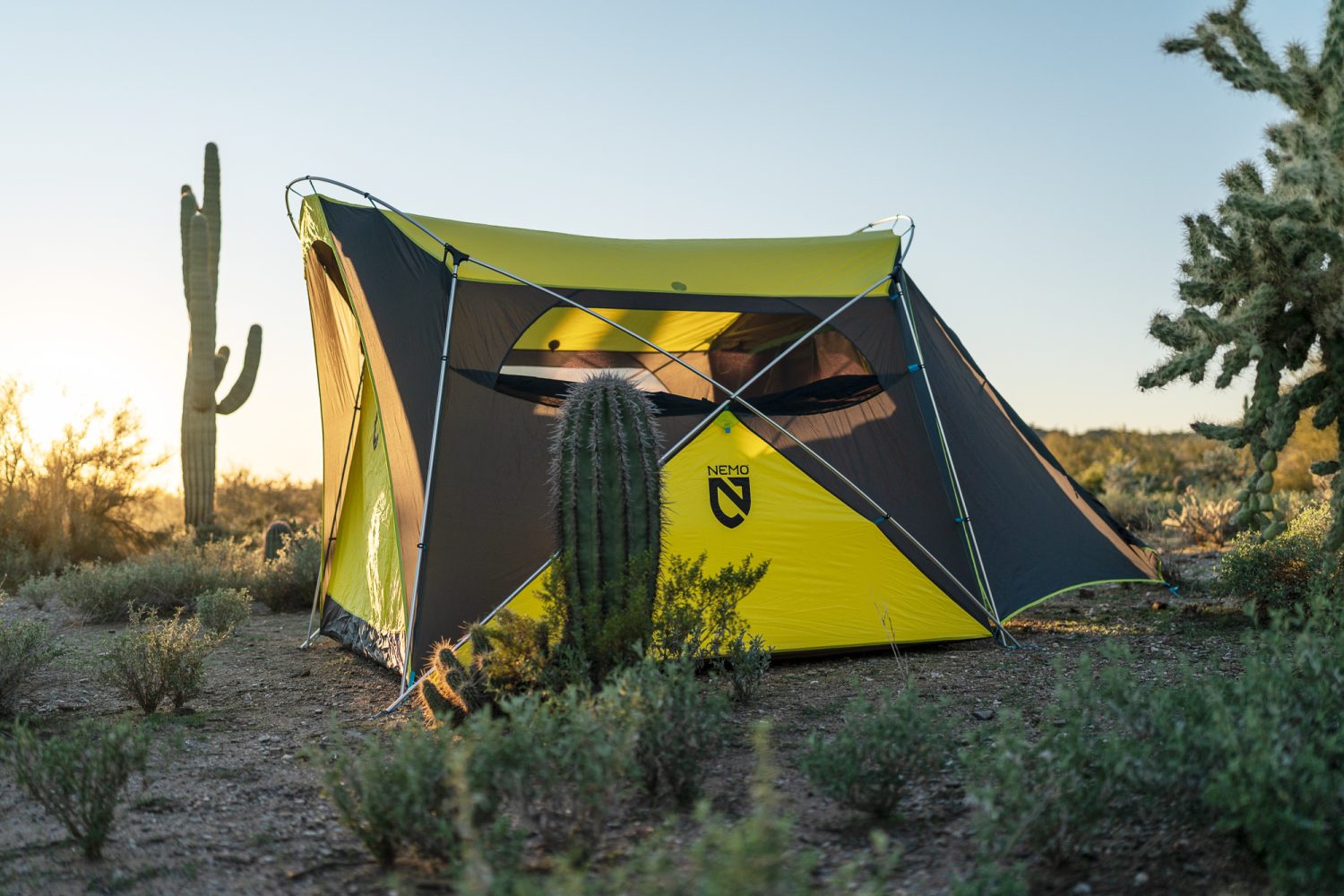
NEMO, which stands for New England Mountain Equipment, was founded by a Rhode Island School of Design graduate who, after an uncomfortable night in a poorly designed shelter, decided that he could do better. Working with fellow designers, he created his first patented shelters that used inflatable air-beam technology. In 2004, NEMO’s first-generation tents were presented at Outdoor Retailer in Salt Lake City to much industry attention and subsequent awards. These days, the company is a household name for outdoor enthusiasts.
While NEMO’s original air-beam tents were complex, the WagonTop 4 is a much simpler design that is perfect for small families or individuals who like standing room in a more traditional square footprint (offered in 6- and 8-person versions as well). It has a packed weight of just over 20 pounds.
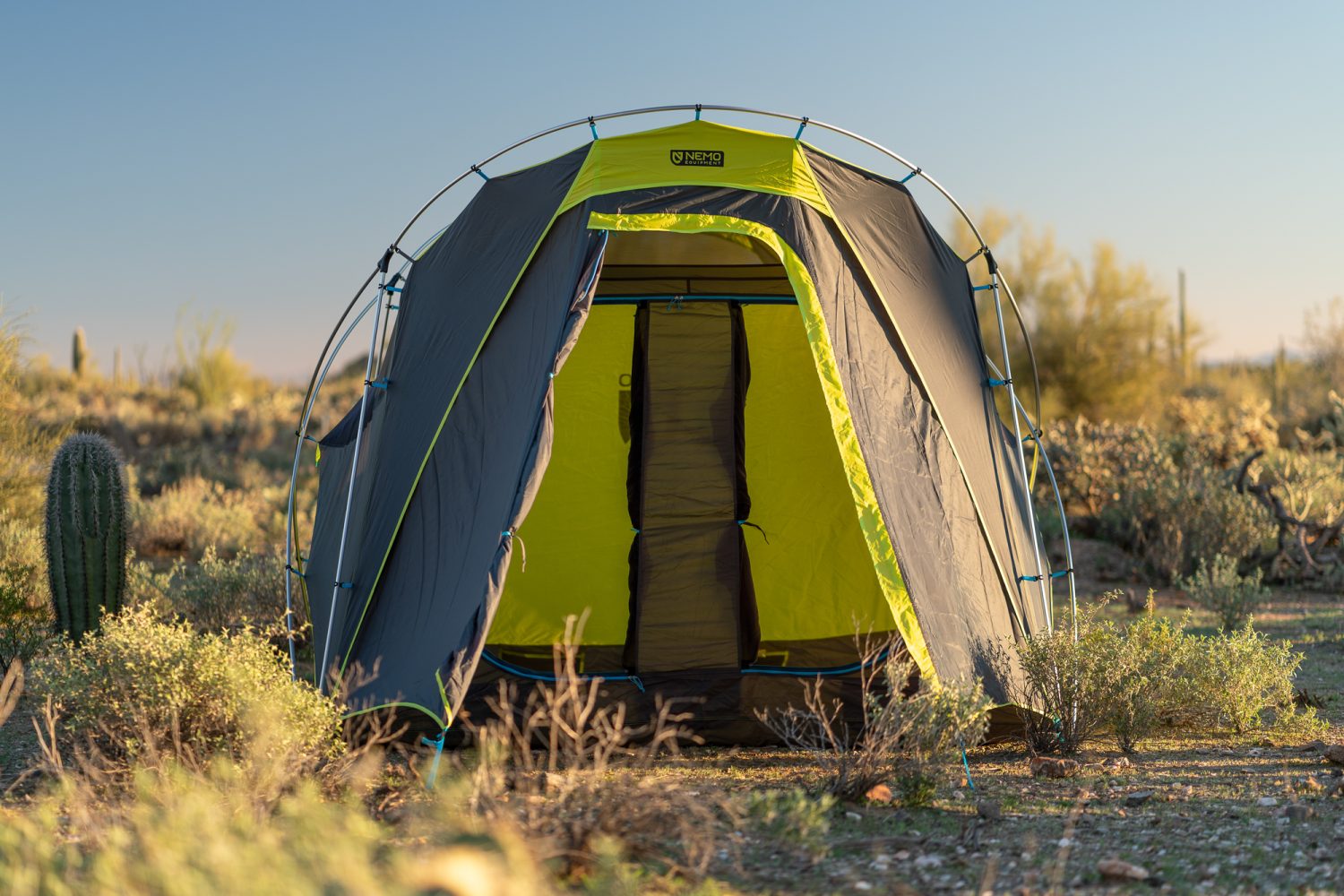
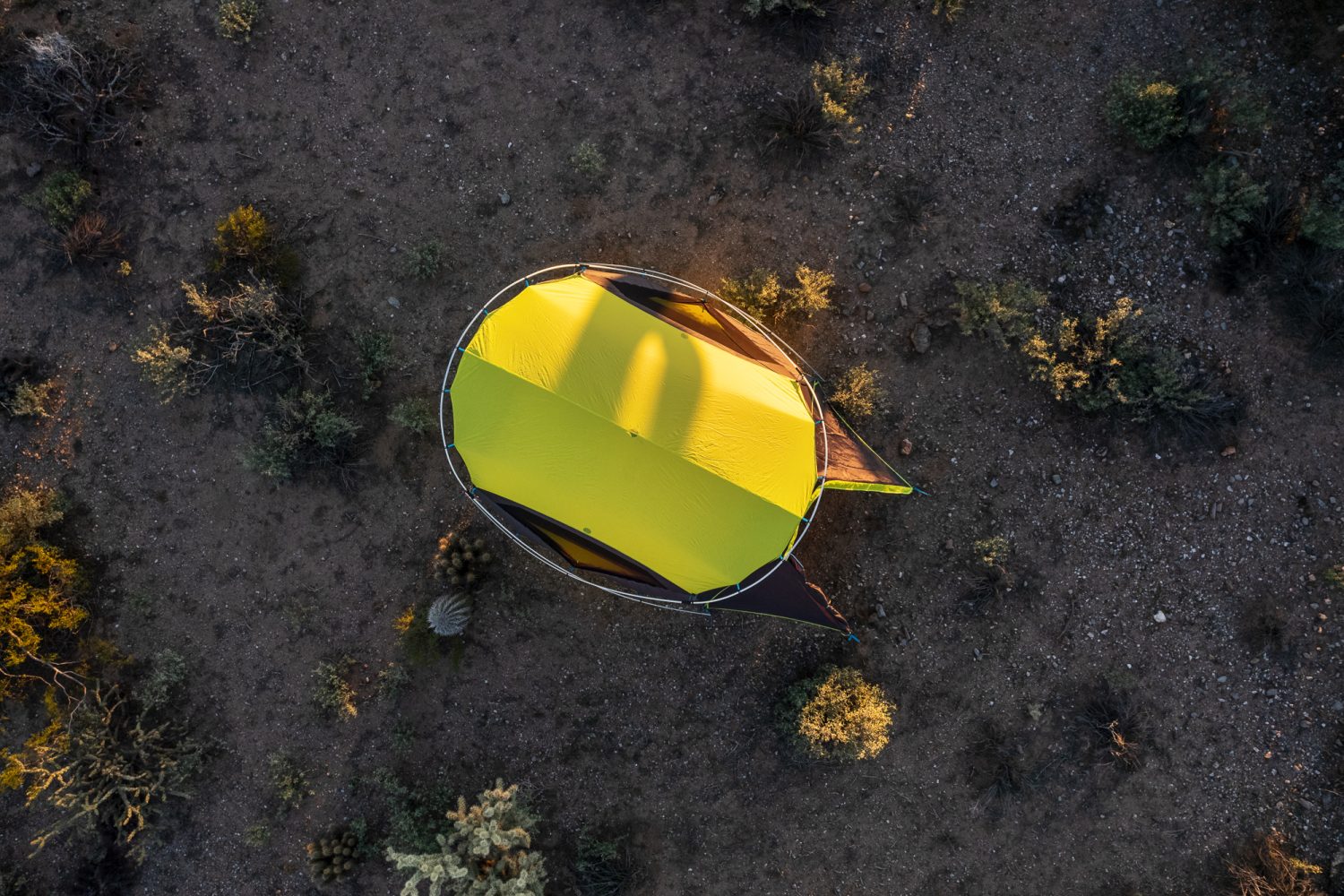
.
I found the WagonTop quick to set up, taking just 21 minutes the first time, even without prior experience or instructions. Its two aluminum poles were long and somewhat unusual in shape, which resulted in a little bit of confusion. However, after taming them and staking out the WagonTop with the included stakes, the result was a surprisingly stable shelter that held up to multiple days of strong winds in the desert. I appreciated its nearly vertical sidewalls that provided a large amount of usable interior space. The removable vestibule provided additional utility for storing gear at night, although because it is located in front of the only door, you’ll want to place items to the side so that you can exit the tent easily.
One of the WagonTop’s most innovative features was the use of elastic windows, replacing traditional zippered ones. Because zippers are one of the things that commonly fail in outdoor gear, it’s a clever idea that could increase the usable life of this tent. I never experienced driving rain during my testing, but given the coverage of the windows in the closed position, I am confident that they will prevent water ingress in all but the most extreme conditions.
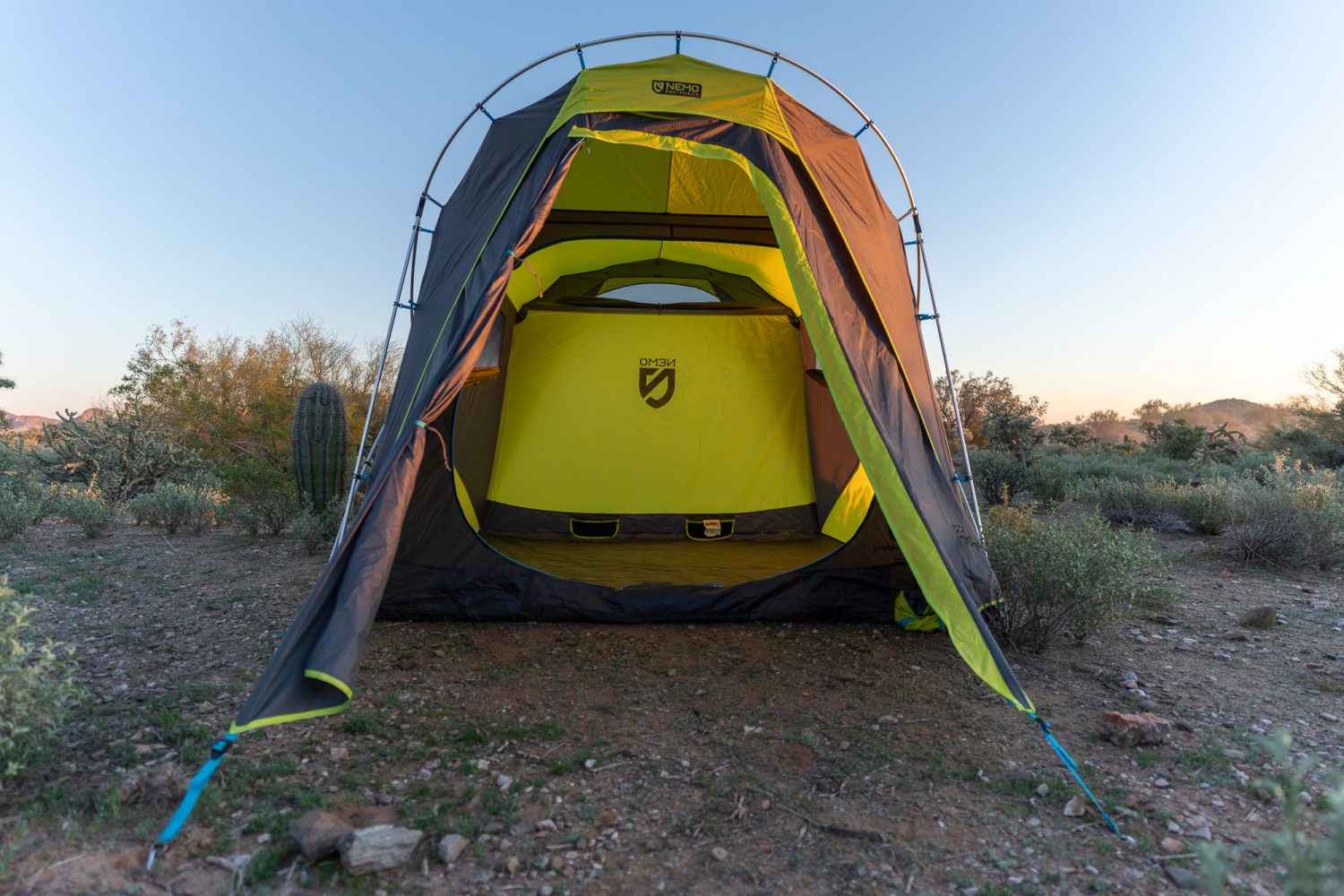
Though large, I found the tent’s front door to be a little strange; if you want to open it completely, it zips down to the ground resulting in the fabric laying on the floor instead of rolling up and being secured overhead. But aside from this one minor nitpick, the WagonTop felt like a solid contender. And given its price point, this tent is still affordable for the amount of space, sturdy structure, and features that it offers.
$550 | nemoequipment.com
REI Half Dome 2
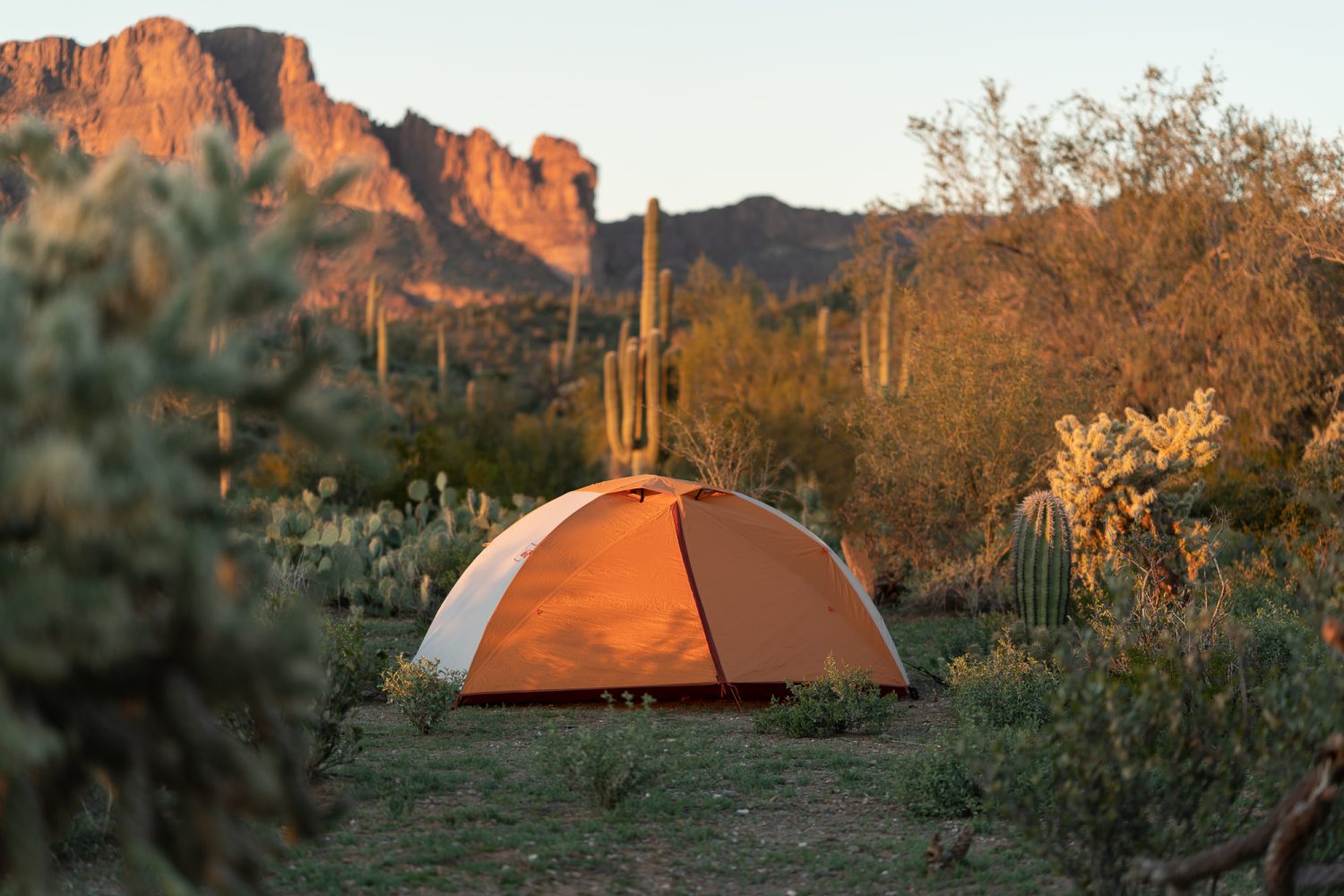
There is absolutely nothing wrong with using backpacking gear for overland travel. From a practical standpoint, it is probably one of the most affordable yet functional ways to outfit yourself when you are just getting started. This is where REI, aka Recreation Equipment, Inc., comes in, with the added benefit of nationwide retail locations should you need warranty assistance on the road (assuming you are traveling in North America).
The Half Dome 2 is a compact, lightweight, three-season backpacking tent originally introduced in 2001. It has undergone some design changes over the years, and the most current version was released in 2020. At just 4 pounds, 14 ounces, it can still hold its own in wind and precipitation. Because it is a free-standing design, the Half Dome can be pitched on various surfaces, including concrete or wooden platforms, and it doesn’t need to be staked out to maintain its structure.
While there is no standing room, the tent does offer enough interior volume to sit up comfortably and shelter with a friend or loved one. And being a relatively compact tent, I can usually find a flat spot to pitch it since it doesn’t require large, open patches of ground. Although it’s snug, my partner and I have managed to fit our 40-pound dog inside with us on numerous trips.
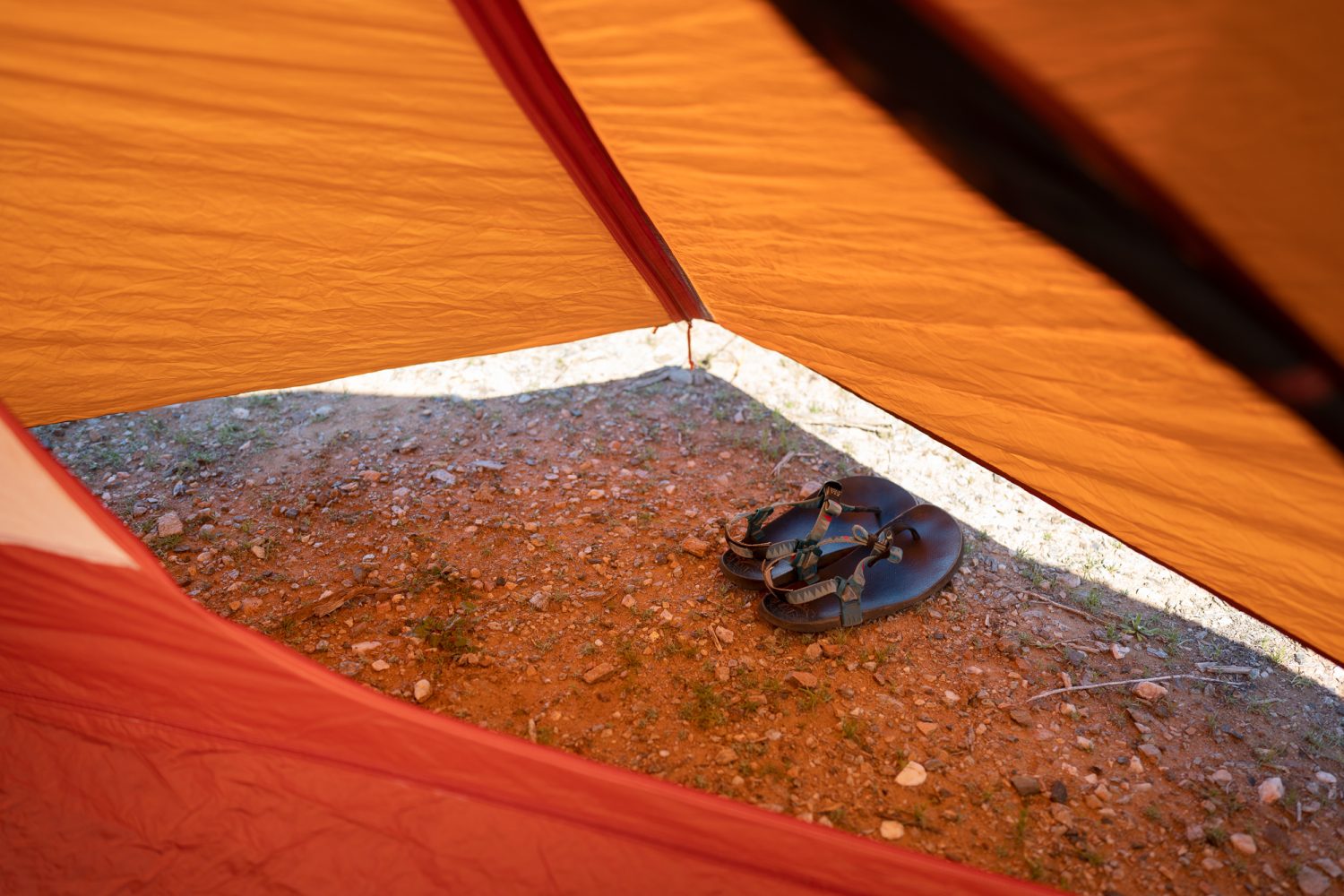
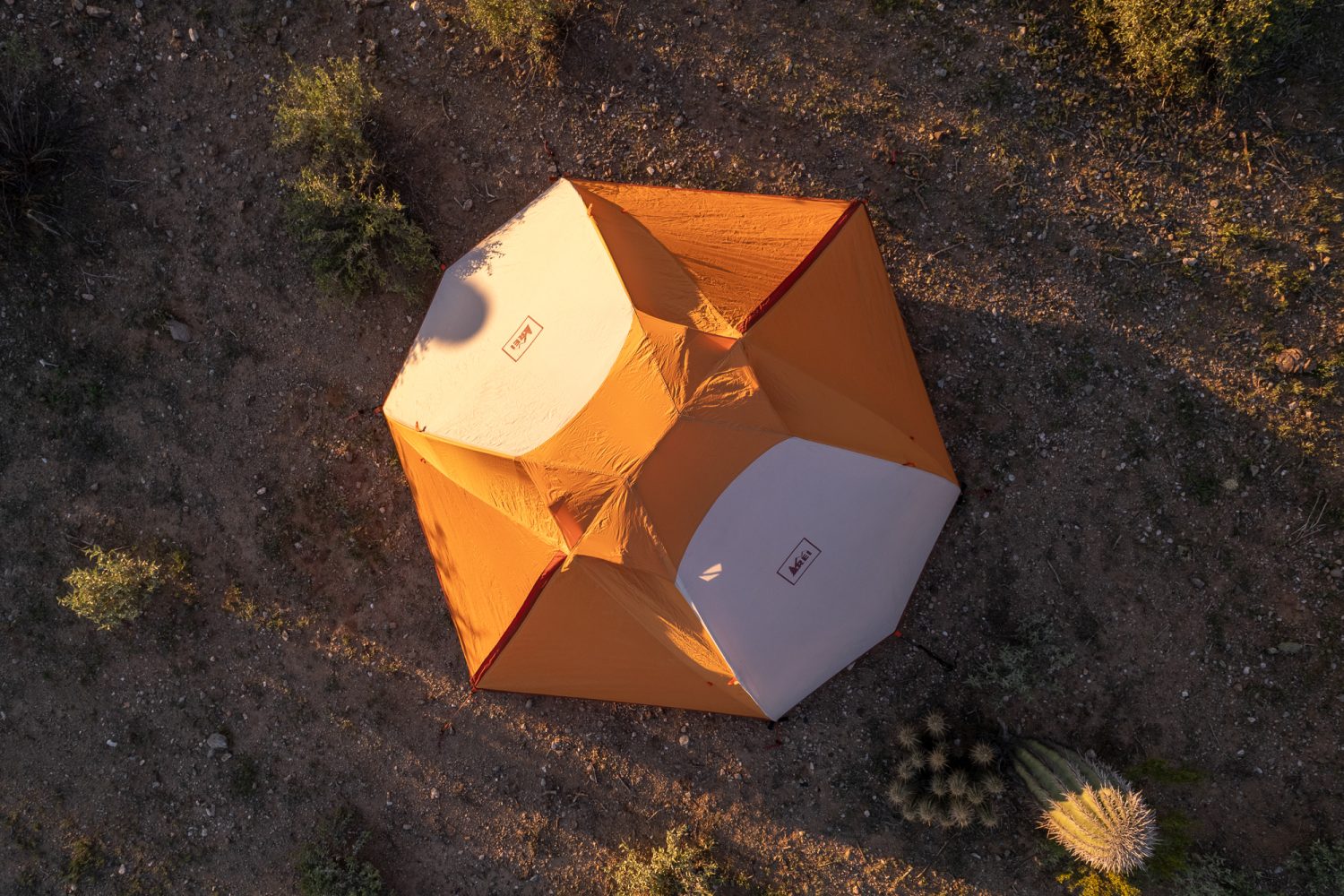
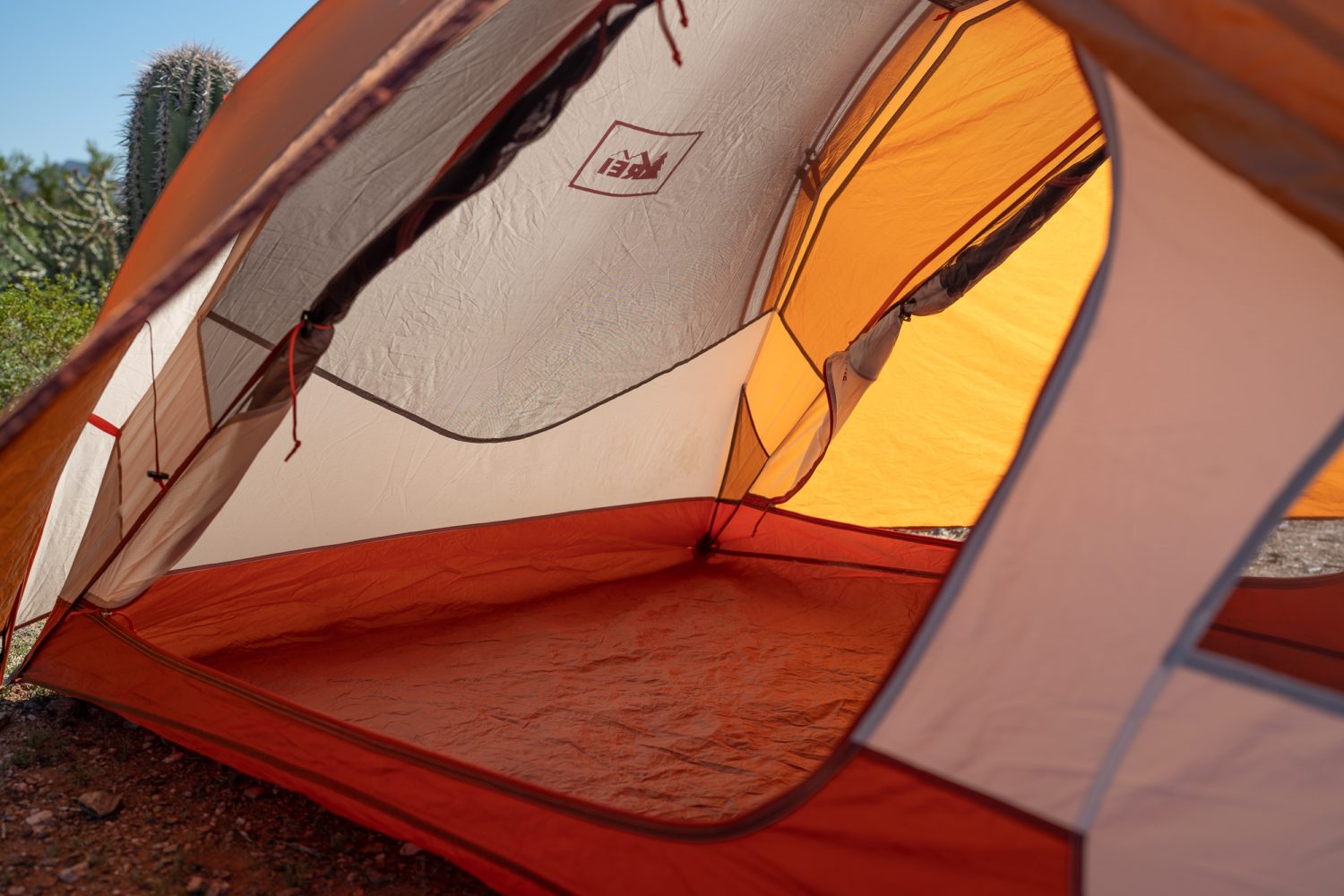
I’ve had a little bit more experience with the Half Dome than the other tents in this test; my setup time has been whittled down to approximately 5 minutes when I’m feeling especially motivated. Familiarity aside, the tent is quick to assemble thanks to its size and fewer stake-out points and is fairly easy to manage when setting up solo. It provides two doors (one on each side) which allows either occupant to exit without disturbing one another, a nice bonus if you need to step out in the middle of the night. The Half Dome also has a variety of mesh pockets for keeping small items like keys or a headlamp from becoming lost amongst sleeping bags or bedding.
With its rainfly installed, the Half Dome offers two vestibules that each provide enough room to store a 50-liter backpack, a pair of boots, and a helmet, while still allowing enough room to exit the tent without too much difficulty.
My version of this tent did suffer from the worn-out tent pole elastic that some customer reviews mention, but despite this flaw, I am still able to use the tent, and it is still just as stable as it ever was.
$230 | rei.com
Seek Outside Redcliff with Large Titanium Woodstove
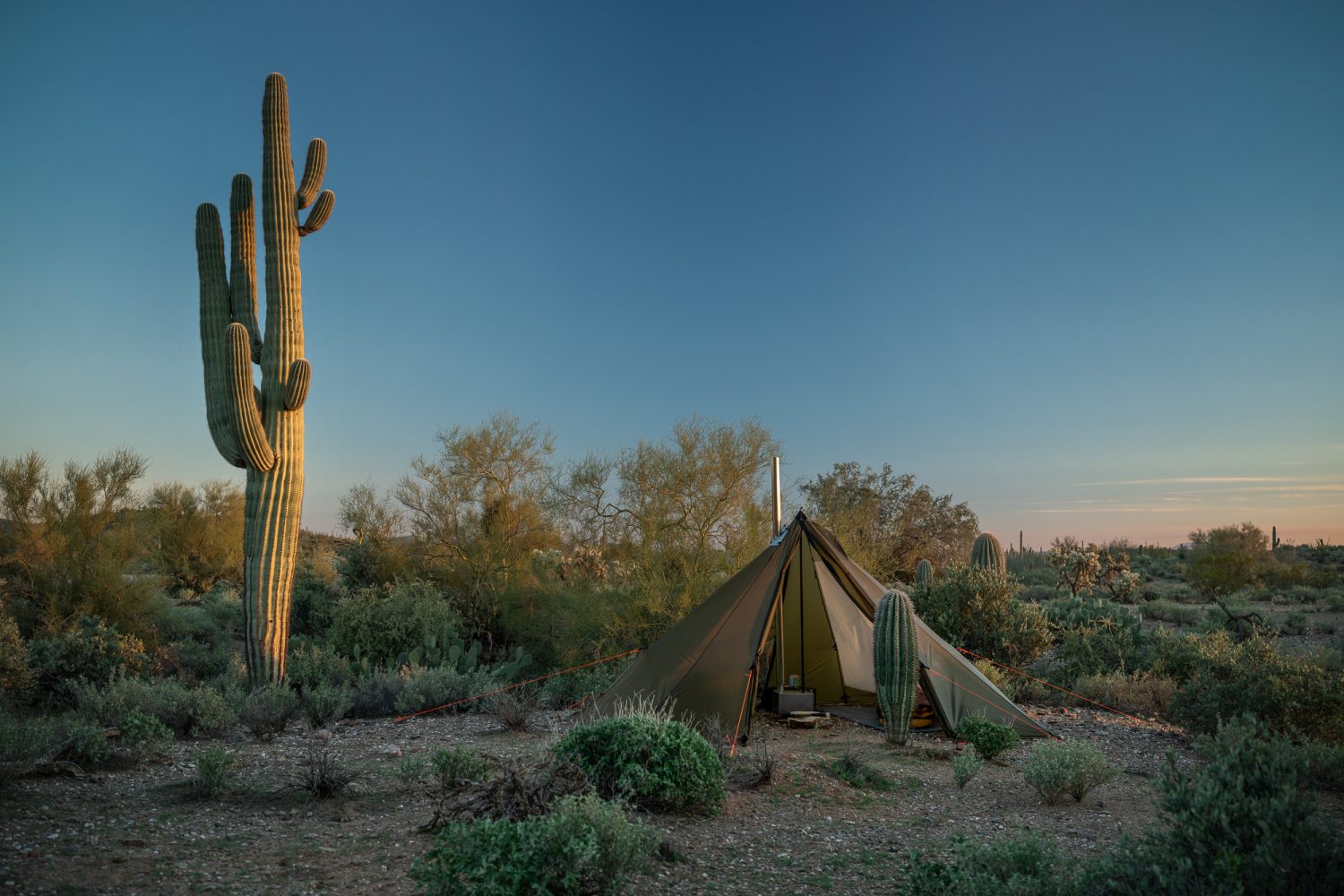
This Redcliff is a single-wall hot tent named after the former mining outpost of Red Cliff, Colorado, a tiny mountain town located 8,750 feet above sea level along the banks of the Eagle River. The tentmaker, Seek Outside, is a cottage brand that makes small batches of tents by hand in Grand Junction, Colorado.
The Redcliff is a floorless, hybrid tipi-style tent that can sleep as many as six adults, yet it weighs approximately 5.5 pounds. Multiple accessories are available, such as a fully enclosed mosquito-proof “nest,” removable liners for added warmth and protection from condensation, or a collapsible titanium woodstove (yes, really).
The initial setup took me over an hour, and some of the supplied tent stakes bent in the process. Despite my belief that I was an expert tent pitcher, I resorted to using the included instructions and watching not one but two YouTube videos. After having my ego put in check, I laid down under the tipi and considered the meaning of life for a bit. There were a handful of setup tasks, like adding the pre-cut cords to the line locks of the liner, cutting and attaching the guylines, or learning how to assemble the stove, which take much less time or are nonexistent after the tent’s initial setup.
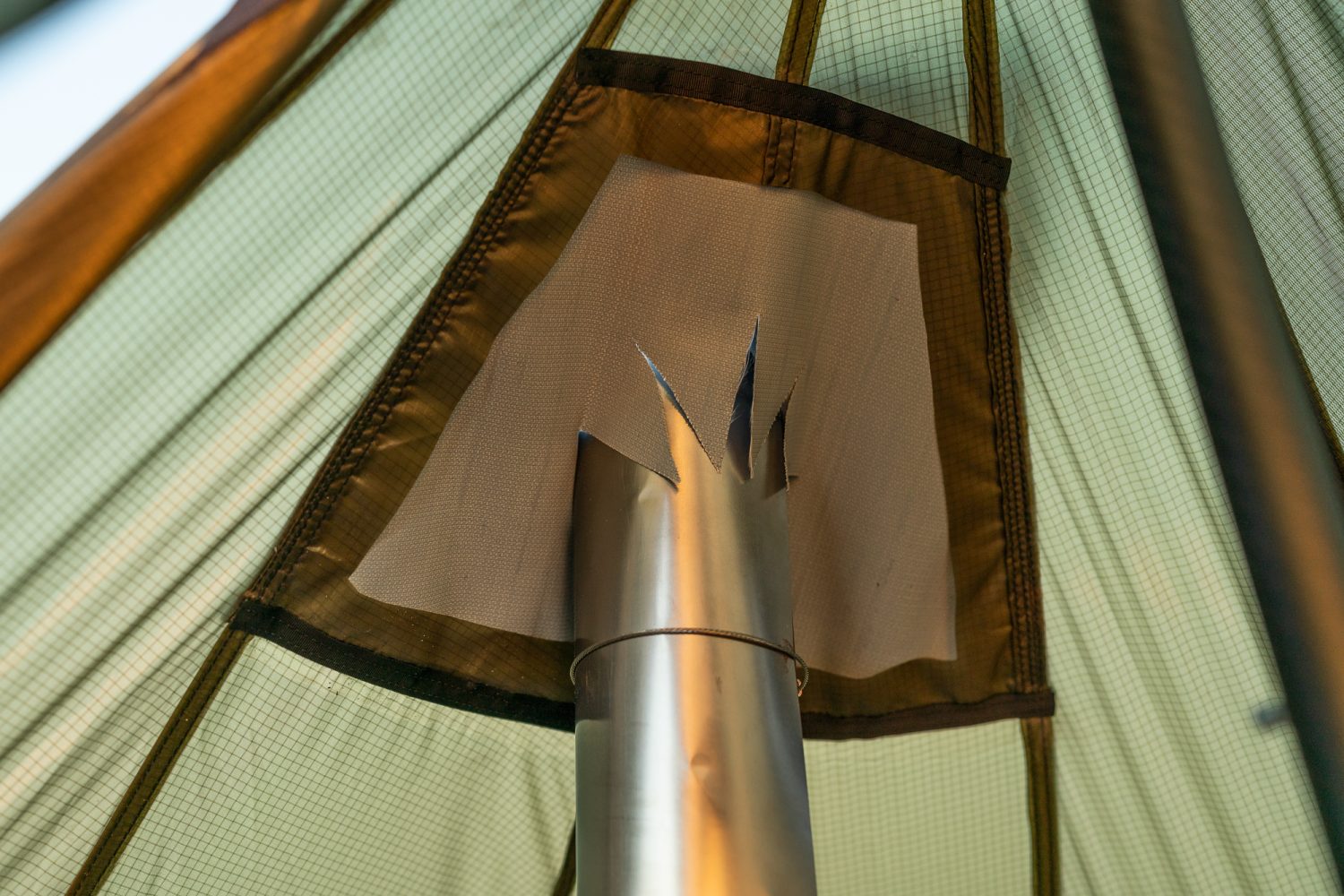
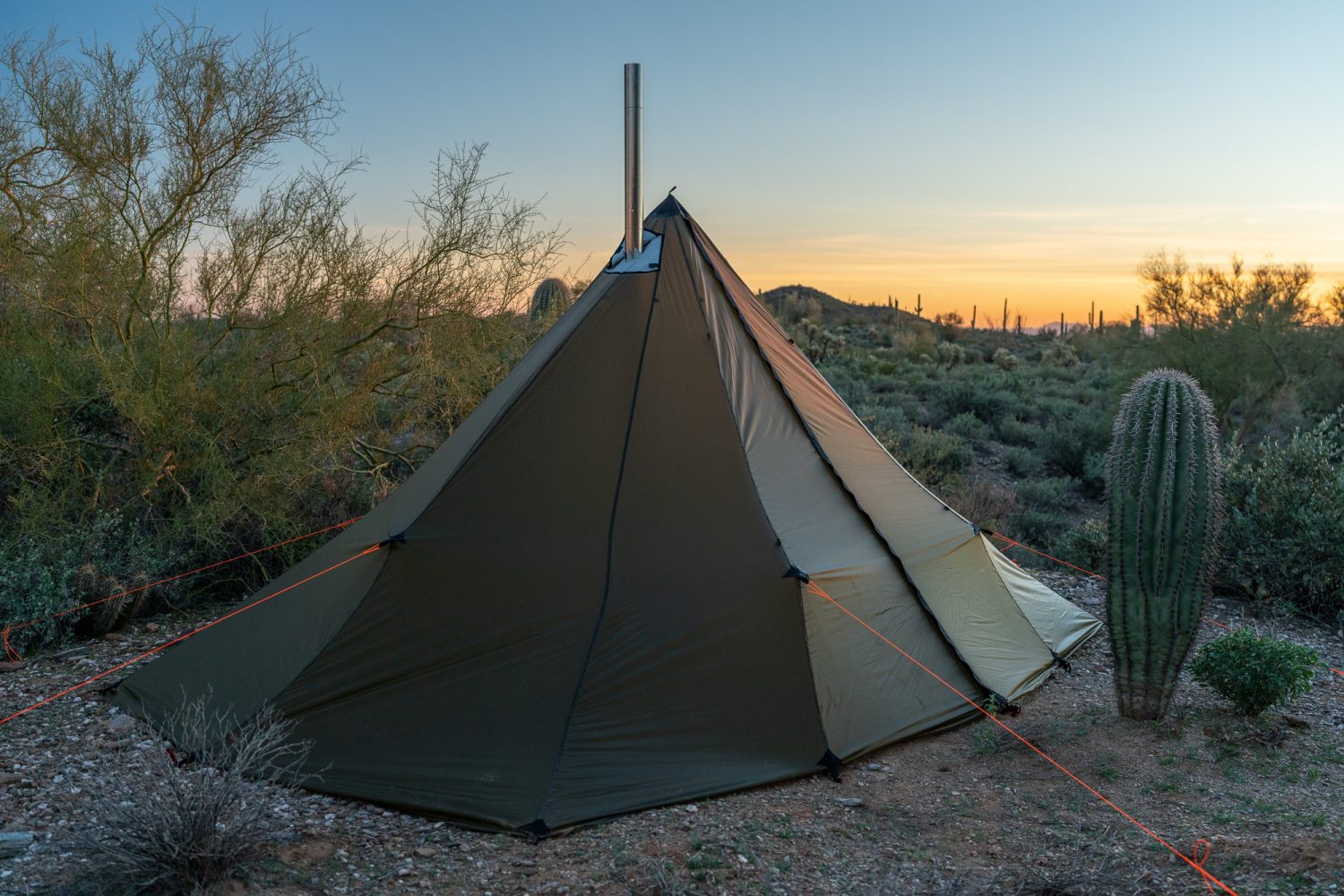
Once erected, the interior of the Redcliff provided plenty of space for two adults plus gear. The woodstove, which ends up being centrally located next to the tent’s single pole, throws off a tremendous amount of heat while it is running. It took me some practice to figure out the ideal damper and venting combination needed for a slow burn. Because the tent lacks the necessary insulation to retain significant heat, the woodstove was best suited to keeping the space comfortable before going to sleep or warming up on cold mornings with the added ability to boil water or even cook a meal (with the appropriate cookware).
I was grateful for the Redcliff’s two large doors, which provided excellent cross-ventilation when opened fully. They both offer integrated mosquito netting, a feature that I am not used to seeing in single-wall tents. I also found the tent’s perimeter skirt to provide additional weather and bug protection by sealing the tent to the ground.
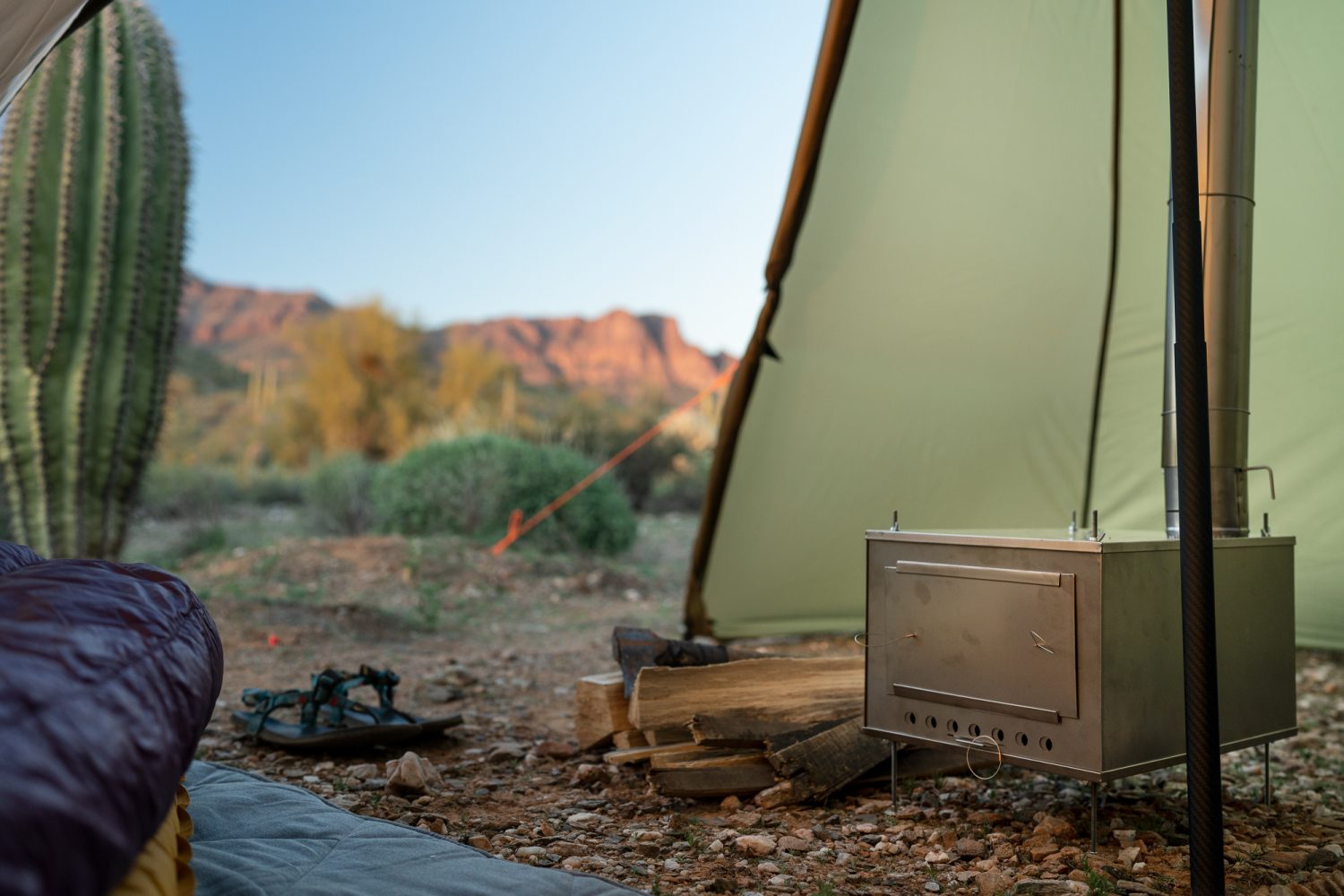
The lightweight design of the Redcliff could be an asset for people who have vehicles with limited cargo capacity like SUVs. Still, users should note that while the silnylon has great tensile strength, it is a fairly delicate material and should be treated with care. If you are concerned about longevity, take comfort in this tent’s warranty, which protects it from defects in manufacturing and material for the practical lifetime of the product. This is a truly unique tent that will please discerning adventurers (you know who you are), but I admit that it’s not for everyone.
$1,700+ (as tested) | seekoutside.com
Springbar Traveler
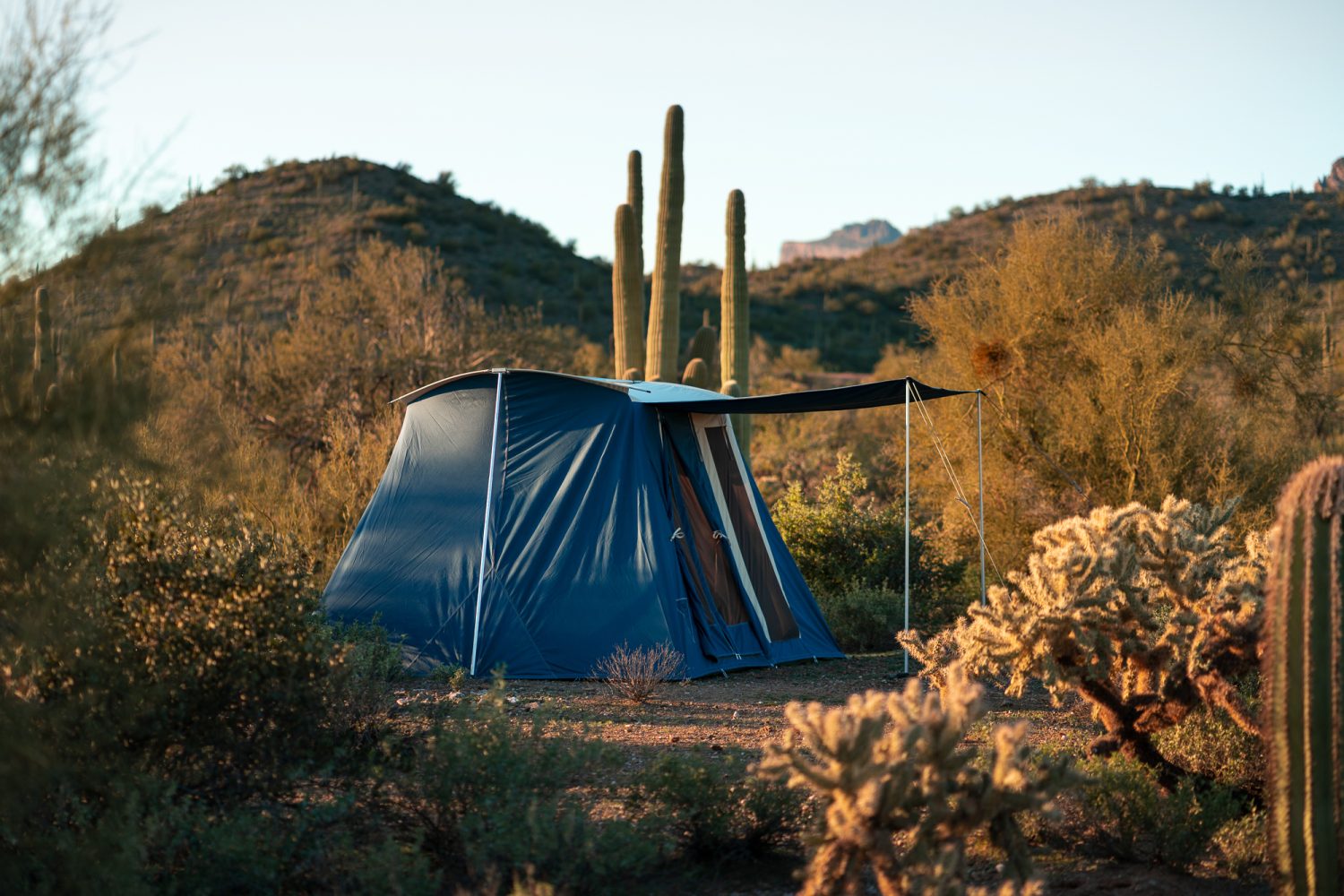
While many outdoor gear manufacturers continue to explore the limits of design with materials like carbon fiber and Dyneema composite fabric, others, like Springbar, have stayed the course with canvas and steel. As someone who can often be found taking out a scale to weigh all of my camping gear and carefully counting and considering each gram, I initially had some reservations about this 60+-pound tent. But those worries quickly melted away the first time I stepped inside.
With nearly vertical walls, a 10- by 10-foot footprint, and a ceiling over 6 feet high, the Traveler is an extremely spacious tent. It was also the heaviest in our test, with heavy-duty materials that inspired confidence with the quality of its construction. From the steel stake-out points to its seamless vinyl floor and 8.5-ounce Sunforger duck canvas walls, I was never worried about the tent’s ability to hold up to the sharp and windy Arizona desert. Additionally, every piece of this tent is sourced in the US, with manufacturing taking place at Springbar HQ in Salt Lake City, Utah.
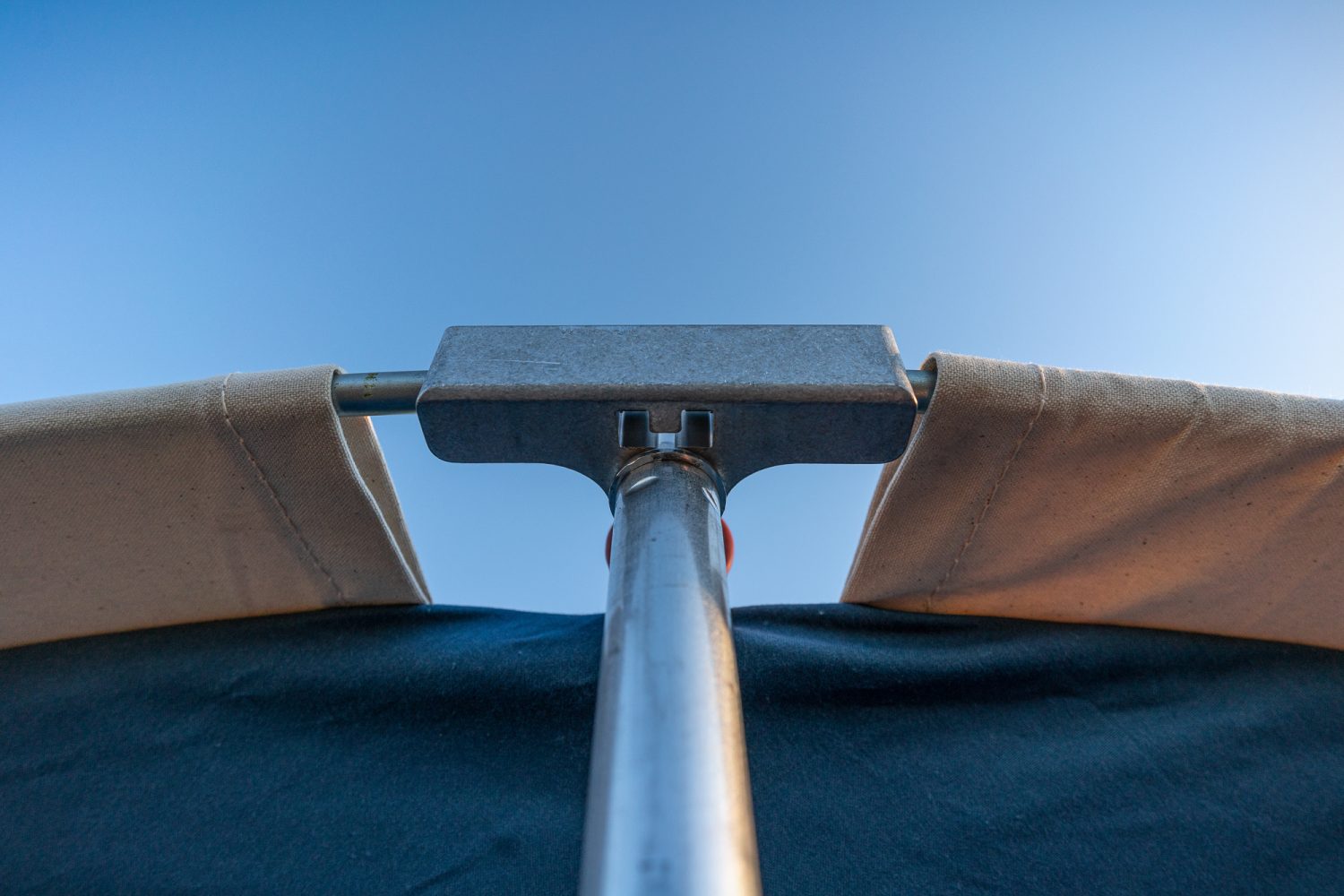
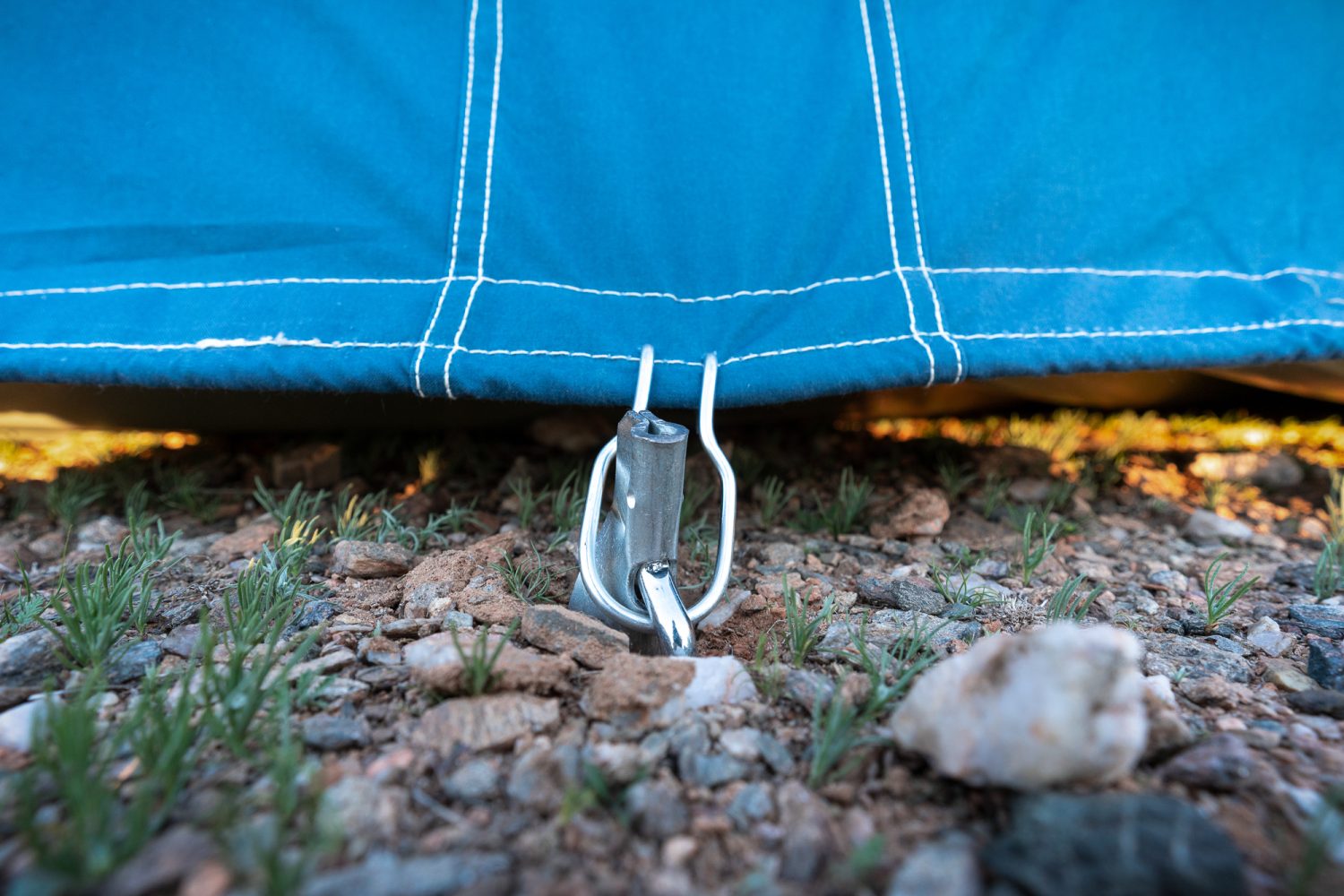
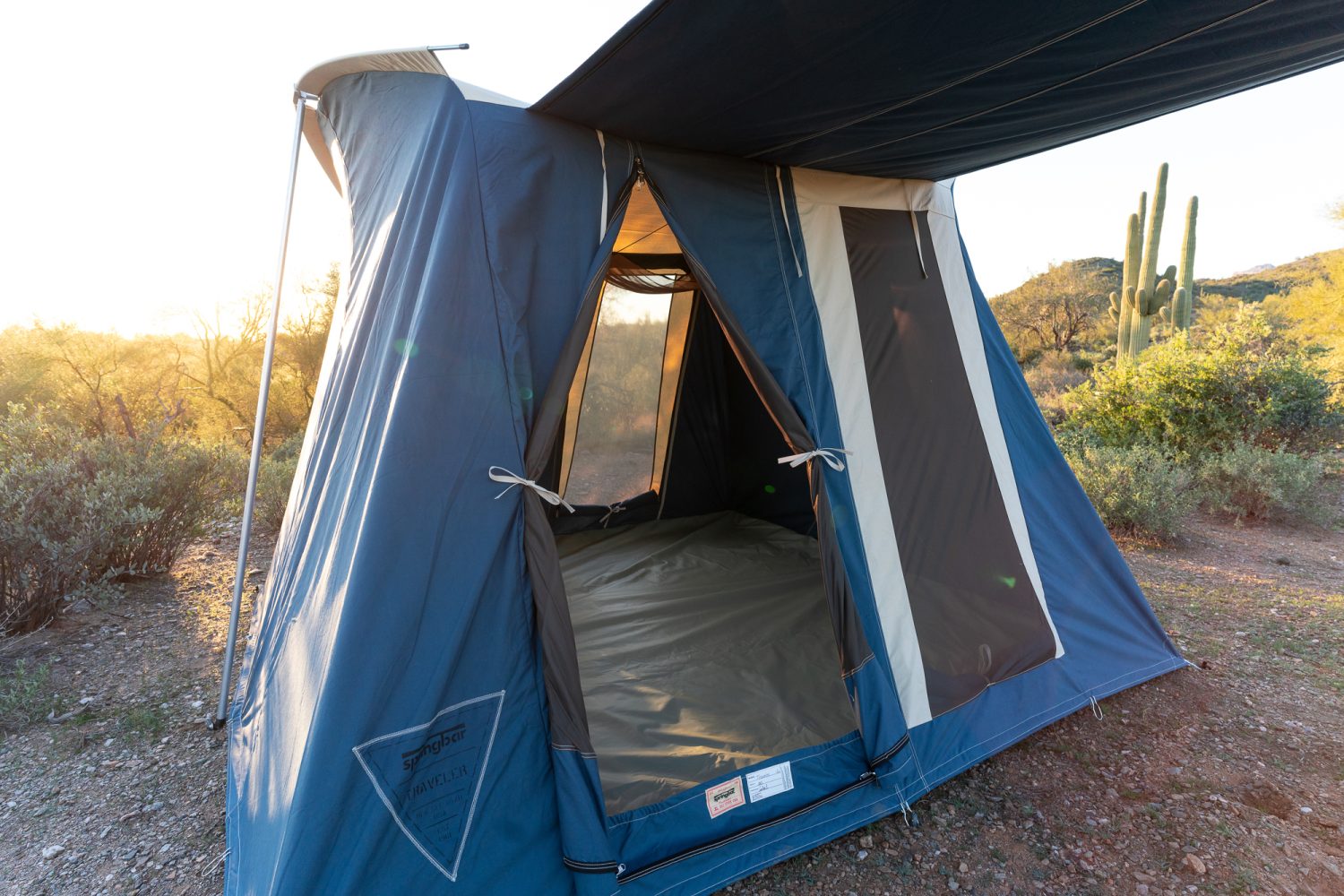
When it came to setting up the Traveler for the first time, I did have to resort to looking at a YouTube video to figure out how the poles that support the tent’s ceiling work. But once I had this figured out, the whole process only took me 30 minutes solo. Even though the nearly vertical shape of the Traveler is not optimal for windy environments, fully staking out its 16 steel loops to the ground (and two awning guylines) results in a solid pitch that inspires loads of confidence.
One of my favorite qualities of the Traveler is its incredibly robust vinyl floor, the heaviest of any tent in this test. After carefully laying the tent out in a rocky area, I realized that I had placed it on top of the stump of a spiny desert shrub. However, I was impressed that despite this less-than-ideal orientation, nothing poked through the floor, despite me walking in and out of the tent for multiple days. For those of you who frequently camp on abrasive or sharp surfaces, an optional footprint is available for this tent to provide additional protection for its floor.
One final feature of the Traveler that stood out, especially in the desert sun, was the front veranda which staked out with two additional metal poles. It provided a shady area completely open to the breeze, with enough coverage for multiple camp chairs.
$1,299 | springbar.com
Hilleberg Keron 3
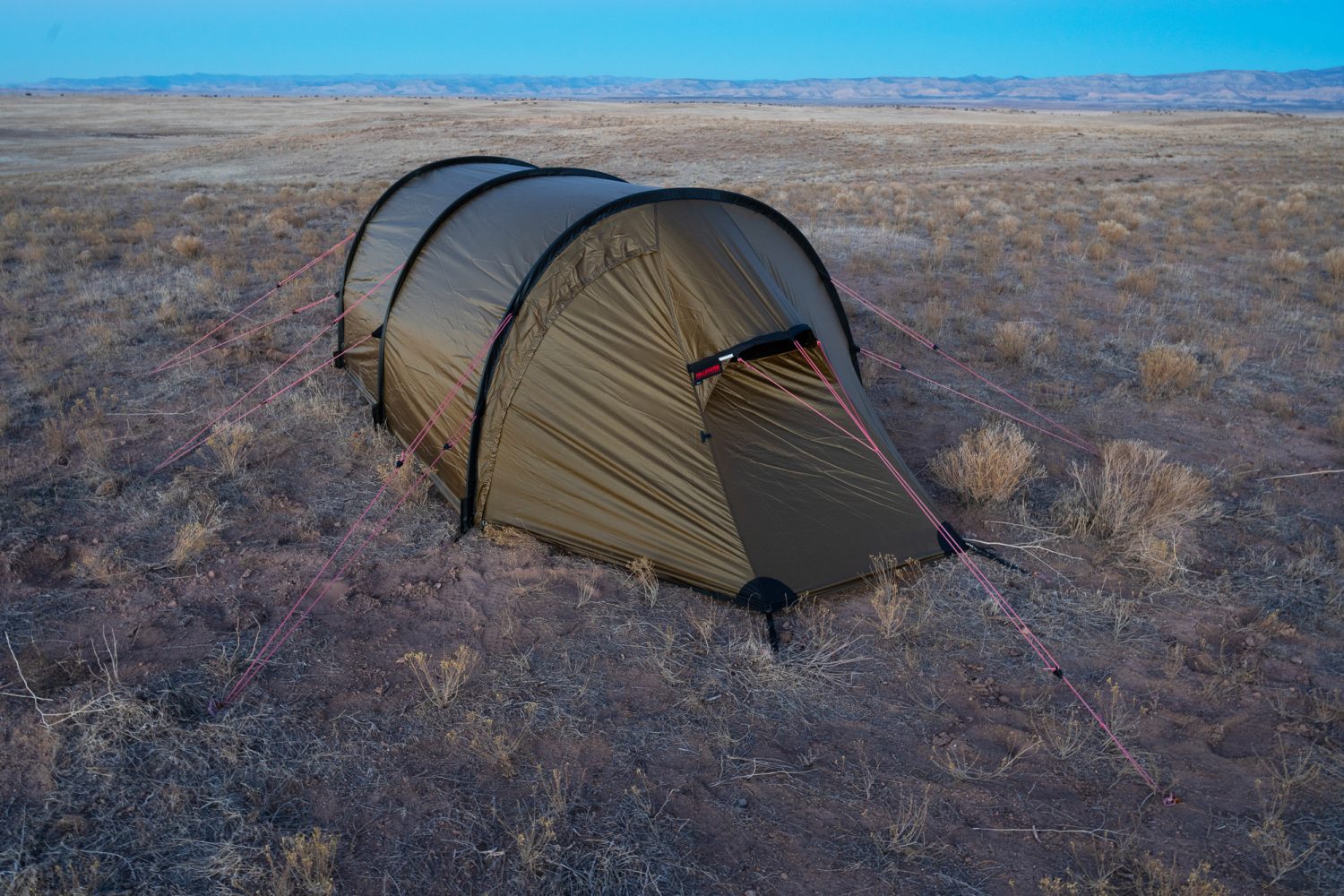
We don’t generally like to play favorites around here, but when it comes to ground tents, few have impressed me like Hilleberg’s Keron 3 tunnel tent. This Swedish tentmaker has been designing and building tents since the 1970s, and their five decades of experience are obvious. The design and construction of their products are impeccable, but to be honest, what Hilleberg offers is going to be overkill for the vast majority of overland travelers. Then again, if you were going to drive across the Greenland ice sheet (*cough*, Scott Brady), I can’t think of a better shelter to bring along for the ride.
The Keron 3 requires a solid pitch for it to perform its best. Without instructions, setup took me roughly 35 minutes, but I significantly reduced this time with multiple uses. Because of its oblong shape, the direction of the prevailing wind should be taken into account. This tent consists of a waterproof outer fly and an inner mosquito-proof sleeping area. While most tents support the fly, the Keron does the opposite, and the outer fly provides the structure for the inner tent. Because of this unique setup, the fly can be pitched independently of the inner tent, allowing you to pare it down from its full-up weight of 9 pounds, 4 ounces, for activities that demand a lighter load, like motorcycle touring or backpacking.
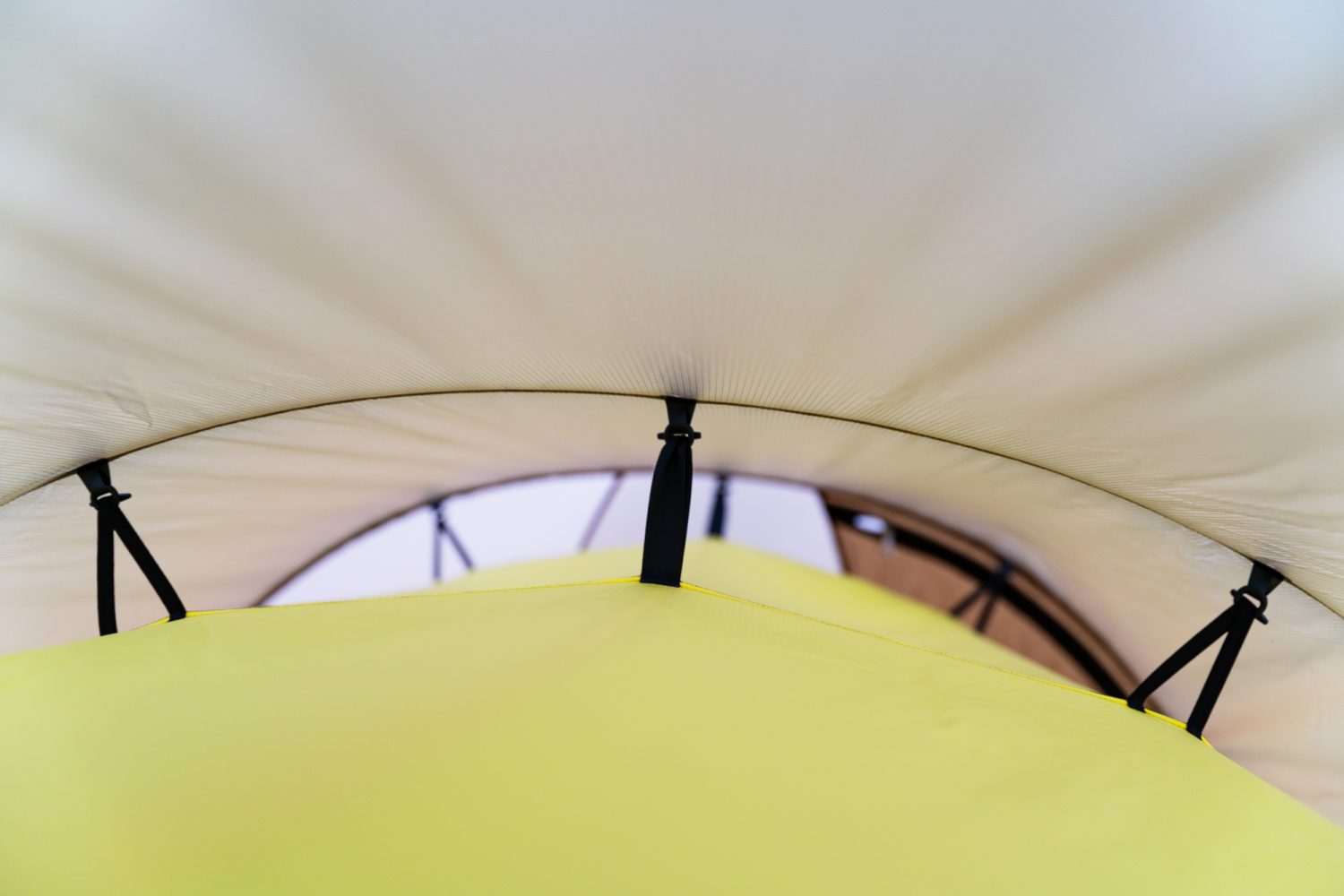

The three in the Keron 3 refers to its capacity, but I think this tent is much more appropriate for two individuals (plus dog). With two occupants, we were able to sleep very comfortably, with all of our gear in the inner tent. For travelers who have even more kit, the Keron’s spacious vestibules provide additional weather-protected storage space.
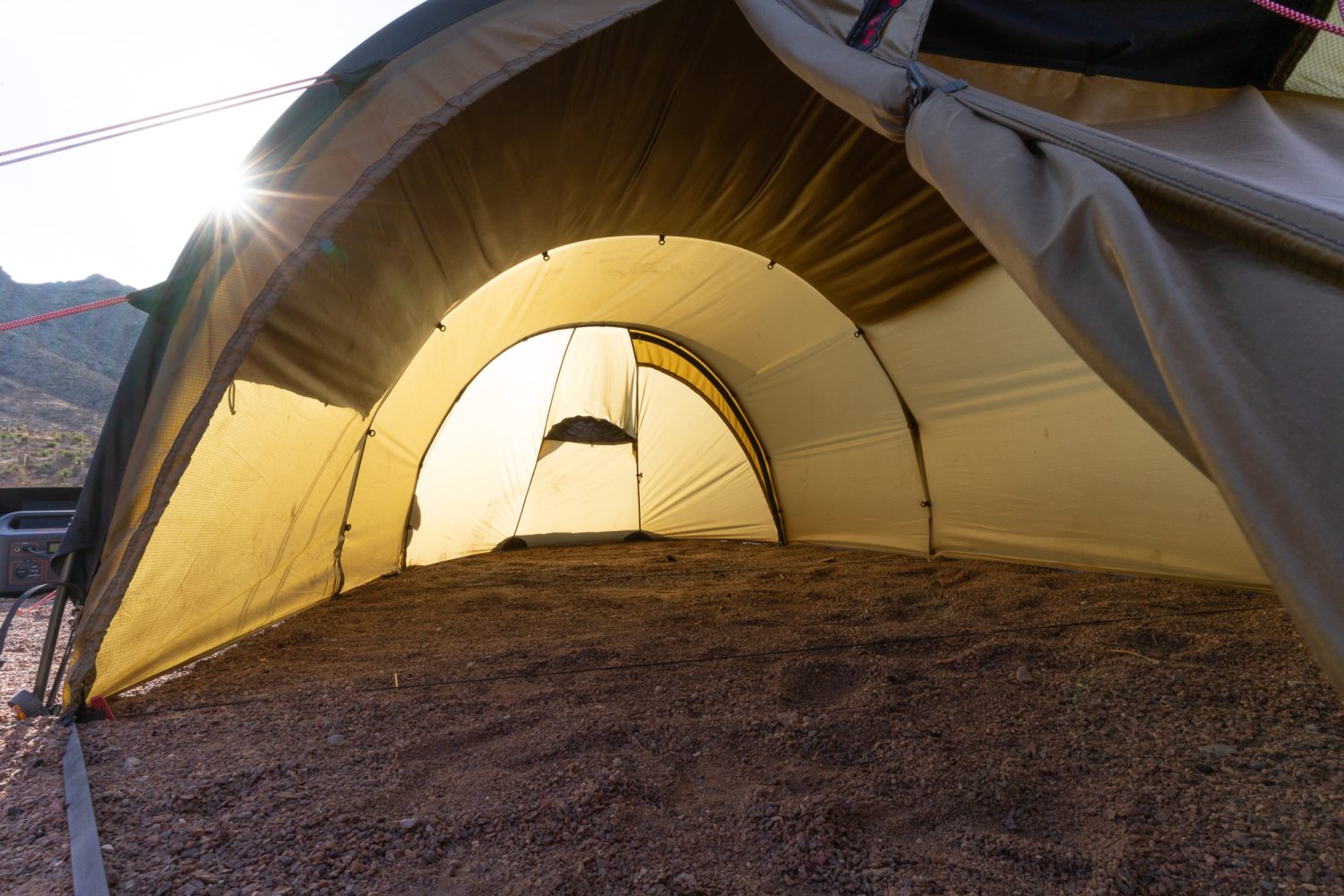
Because it is a much more compact tent, you won’t be able to stand in the Keron. But that fact may not bother you when you marvel at the quality of its construction and its thoughtful details. Inside the body, large pockets in every corner provide convenient storage for items like headlamps, phones, or a book. A cord that runs the length of the ceiling, providing an additional place to hang random items. Huge windows with mosquito netting can be found at both ends, providing excellent ventilation. There are also doors and vestibules at either end, making it easy to exit the tent. The zipper pulls, plastic hardware, and reinforcements in high-wear areas inspire confidence in the overall design and construction of this seemingly bombproof shelter.
While the Keron 3 comes with a steep price tag, its lifetime warranty on materials and craftsmanship makes the number a bit easier to justify.
$1,135 | hilleberg.com
Tent Rundown
Big Agnes Mint Saloon Ideal for larger groups in fair weather, the Mint Saloon is a versatile tent that can serve as a bunkhouse or a mess hall. Plenty of standing room makes for a comfortable retreat from the weather, although the structure, which is limited by the pole’s layout, places this in the lighter-use category.
NEMO Wagontop 4 This straightforward square floor plan is perfect for small families or couples who want standing room and need a tent that can hold up to regular use. While I wouldn’t suggest living out of this one full-time, it can certainly hold up to wind and rain, and its sizeable front vestibule provides a protected area for storing some gear at night.
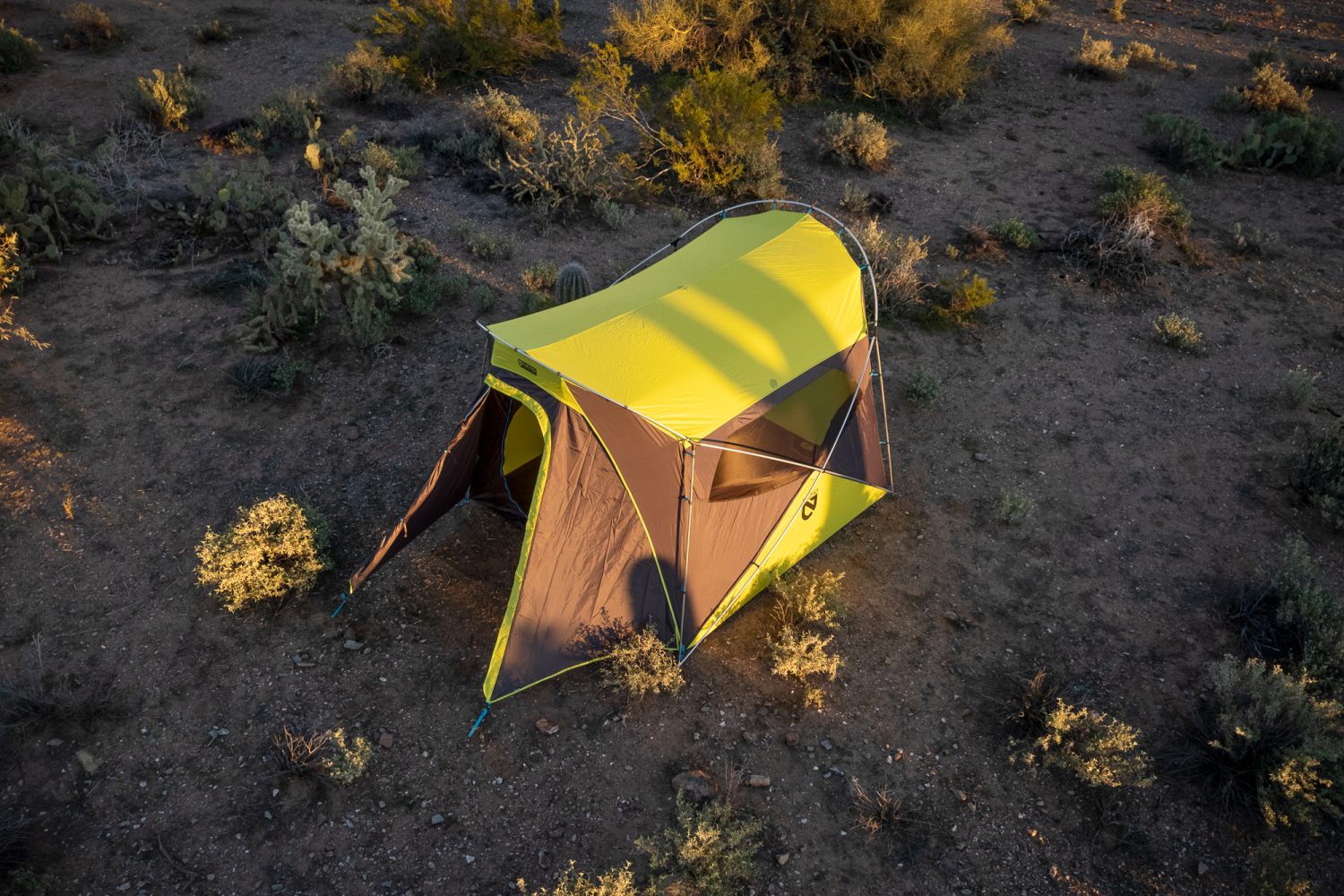
REI Half Dome 2 This lightweight and compact two-person tent will fit just about anywhere, including the trunk of a compact sedan or the rear rack of a dual-sport bike. It offers limited interior space, but at the bargain price of $230, it is a much more affordable option if you are on a budget and would prefer to spend your money on the adventure instead of pricey gear.
Seek Outside Redcliff and Stove For travelers who frequent cold environments but still plan to sleep in a tent, the Redcliff with an integrated wood stove would be my choice. Even though the setup takes a higher level of skill, the shelter provides good stability in wind, ample interior space with some standing room, and one of the lightest packed weights out of every tent that I tested. The materials used in the Redcliff’s construction are strong but not designed for abuse. Given my experience with silnylon, this tent should hold up to many nights of use if used with care.
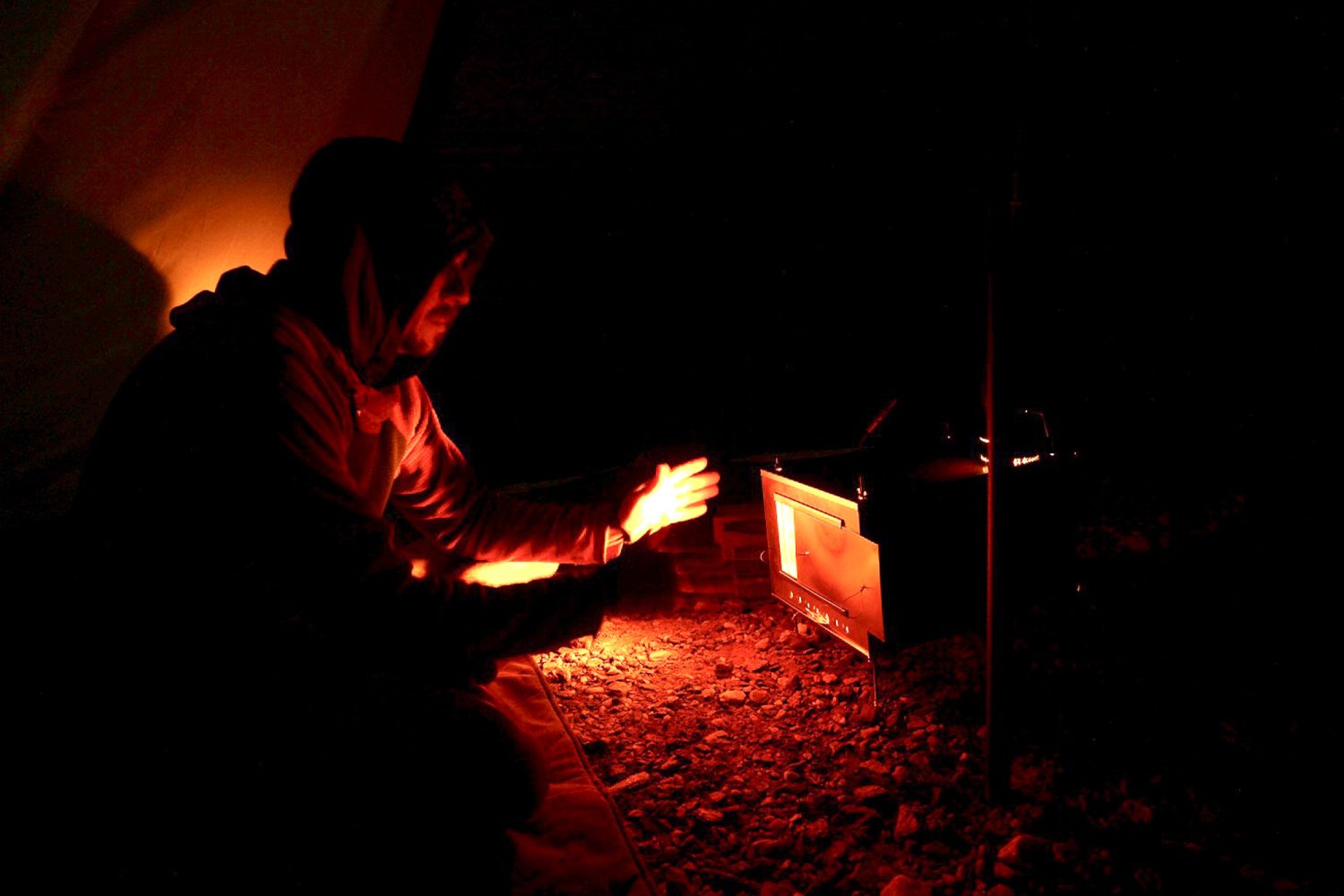
Springbar Traveler If you like classic designs and super durable materials, the Traveler from Springbar is the tent for you. While it was the heaviest product in my test, at 62 pounds, it also inspired a great deal of confidence in the quality of its construction. Plenty of stake-out loops made for a very solid pitch. My only reservation about this tent is that prolonged use in humid, damp environments could be problematic for the cotton canvas. But, to be fair, I could not test this theory, so take my suggestion with a grain of salt.
Hilleberg Keron 3 If your overland adventures take you to the polar regions or you plan to encounter severe, windy weather for extended periods (Patagonia, for instance), I would suggest a tunnel tent like the Hilleberg Keron 3. While it doesn’t offer standing room, the Keron will give you rock-solid shelter from the storm, with high-quality materials and thoughtful design apparent in every part of its construction.
Our No Compromise Clause: We carefully screen all contributors to ensure they are independent and impartial. We never have and never will accept advertorial, and we do not allow advertising to influence our product or destination reviews.
Read more:
NEMO Dagger Osmo Lightweight 3P Tent
Ram 2500 Overland Build :: AEV Dualsport XP Suspension, Salta HD Wheels, General Grabber A/Tx Tires


